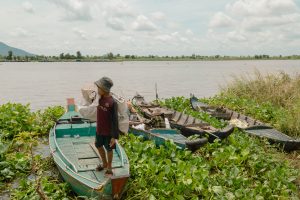The author Tucker Elliot wrote in “The Rainy Season” about the volatile nature of the Mekong:
“No matter the border, the Mekong has been an indiscriminate giver and taker of life in Southeast Asia for thousands of years. It’s a paradox like civilization’s other great rivers – be it the Nile, Indus, Euphrates, Ganges, or China’s Sorrow, the Huang He – for without its waters life is a daily struggle for survival; yet with its waters life is a daily bet that natural disasters and diseases will visit someone else’s village, because it’s not if, but when it’s going to happen that’s the relevant question.”
Generations of people along the Mekong, which flows through six countries, have long had a profound, even spiritual bond with the mighty river: from the highlands of Tibet through the Golden Triangle down to the Mekong Delta, it is one of the most biodiverse freshwater regions in the world, rivaled only by that of the Amazon. For centuries, the transboundary Mekong has been Southeast Asia’s lifeline for millions of people and wildlife. Long considered the “most productive place on Earth” for fishermen and farmers who have come to depend on it, things have changed dramatically for the river’s fortunes, most notably in the last decade.
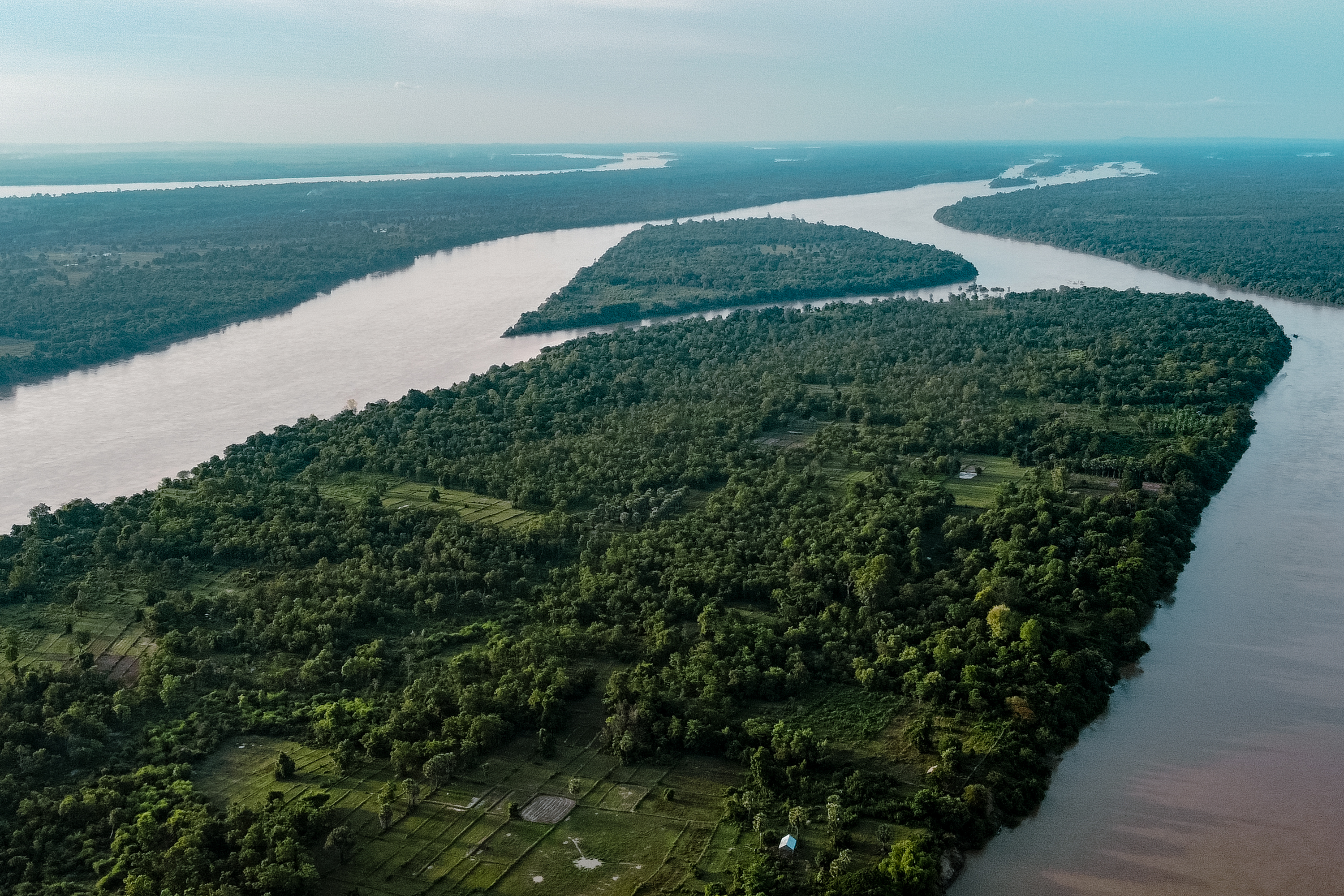
An aerial view of the Mekong in the Sambor district of northern Cambodia, close to the newly revived Stung Treng Dam project. Photo by Nicholas Muller.
Disequilibrium in the Mekong has become the new norm: droughts, floods, and low fish stocks are becoming more frequent. The immense environmental destruction taking place throughout the basin is a consequence of multiple dam projects, mainly constructed by China’s government, which have likely permanently altered the river’s characteristics. Pollution, overfishing, and resource extraction threatens irreversible damage to the delicate ecosystem. According to historical data, 2021 was the 9th driest season on record in the Mekong basin.
To make things worse, a new UNESCO report released just ahead of COP27 warned that numerous icefields around the world are likely to vanish by 2050 which will have a substantial effect on river basins including the Mekong. This will highly affect the basins into which glacier meltwater drains, including half of the world’s biodiversity hotspots. David Dudgeon, emeritus professor of ecology and biodiversity at the University of Hong Kong, recently told the SCMP that climate change would further degrade the Yangtze and Mekong rivers which flow from the Tibetan plateau to Southeast Asia. Both are already “heavily dammed.”
“Dams on the river, and changes to the natural flow regime that would result from glacial melt, would put the food security of large numbers of people at risk,” Dudgeon said.
Other factors are exacerbating the Mekong’s demise. Anthropogenic climate change continues to intensify, heightening the uncertainty of what the next season could bring. Three consecutive years of severe droughts have wrought havoc on the Mekong’s water levels, bringing them to record lows. Simultaneously, the COVID-19 pandemic decimated the income of fishing communities, worsened environmental degradation in many areas, and expanded detrimental fishing practices like illegal electric fishing, which happen without much oversight. As a new dry season approaches, uneven flow can cause severe problems for people: either there is too little or too much water; droughts are often followed by floods.
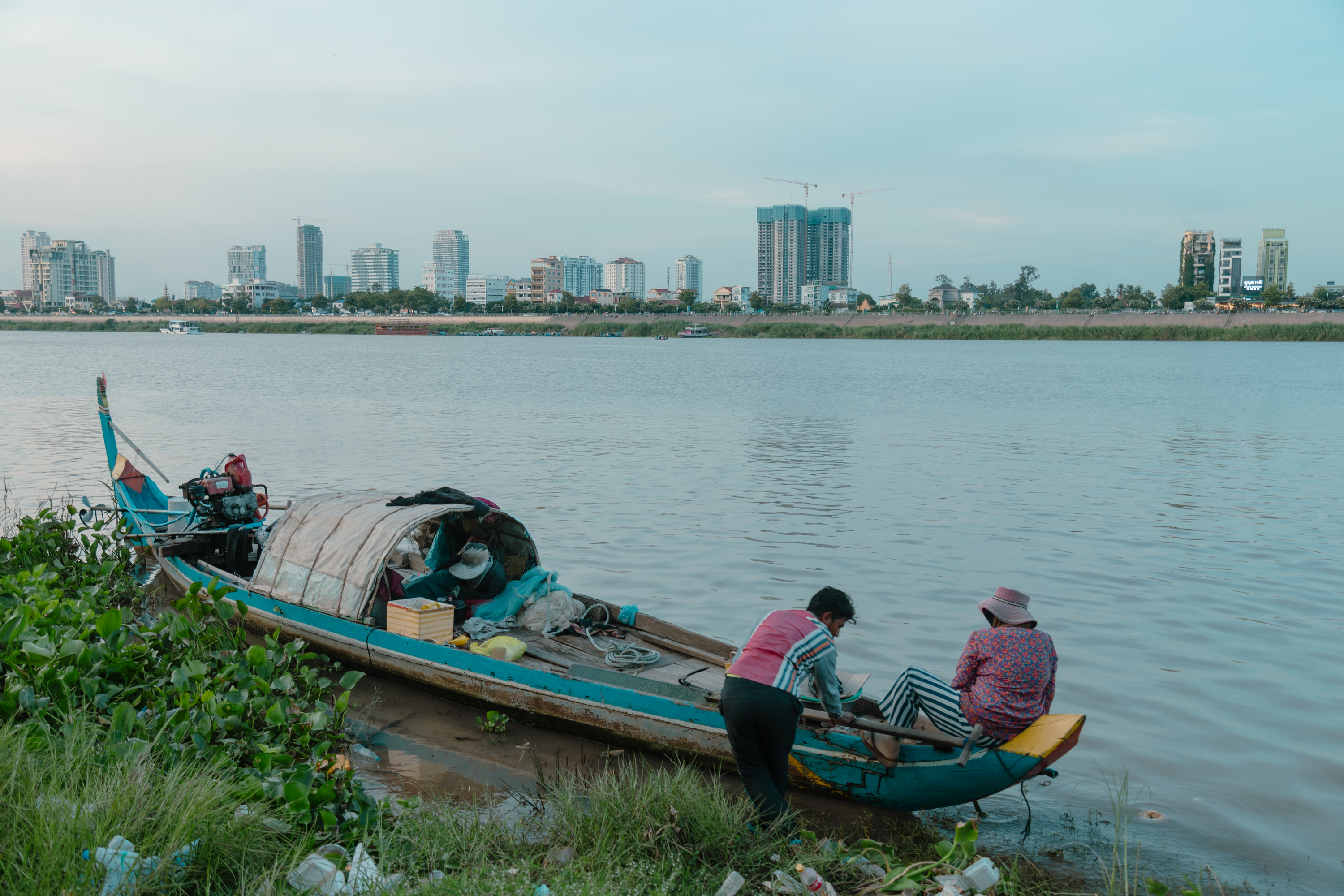
A family at sunset in Phnom Penh, Cambodia. The Cambodian capital has experienced a boom and has increased pollution of the Mekong River significantly in the last decade. Photo by Nicholas Muller.
Risks are also high for lower basin countries that are heavily dependent on fishing and rice cultivation. Their industries are vital, providing half the region’s food supplies. The threat looms largest in Cambodia, where the risk of a food crisis is already heightened. If the Tonle Sap, the world’s largest inland fishery, underperforms in any given year, it can have ripple effects for the entire Mekong region. The lake alone yields a quarter of the world’s total freshwater catch annually and is responsible for 70 percent of Cambodian’s annual protein intake. Throughout the basin, 60 million people stake their livelihoods on income somehow related to fish.
Lucrative sand mining and sediment removal have been twin shocks for the river, accelerating riverbank erosion and adding to the Mekong’s structural decay.
“Sediment is the critical building block of all the resources that come out of the Mekong system. Dams are holding back sediment, which is being mined from the river at a very alarming rate in Phnom Penh and around Cambodia. It’s unregulated, and a lot of it is illegal,” says Brian Eyler, the Southeast Asia program director of the Stimson Center and co-lead of its Mekong Dam Monitor Project.
“Most communities don’t know about what is happening in other sections of the river. The Mekong is dying a death of a thousand cuts from these dams,” says Eyler.
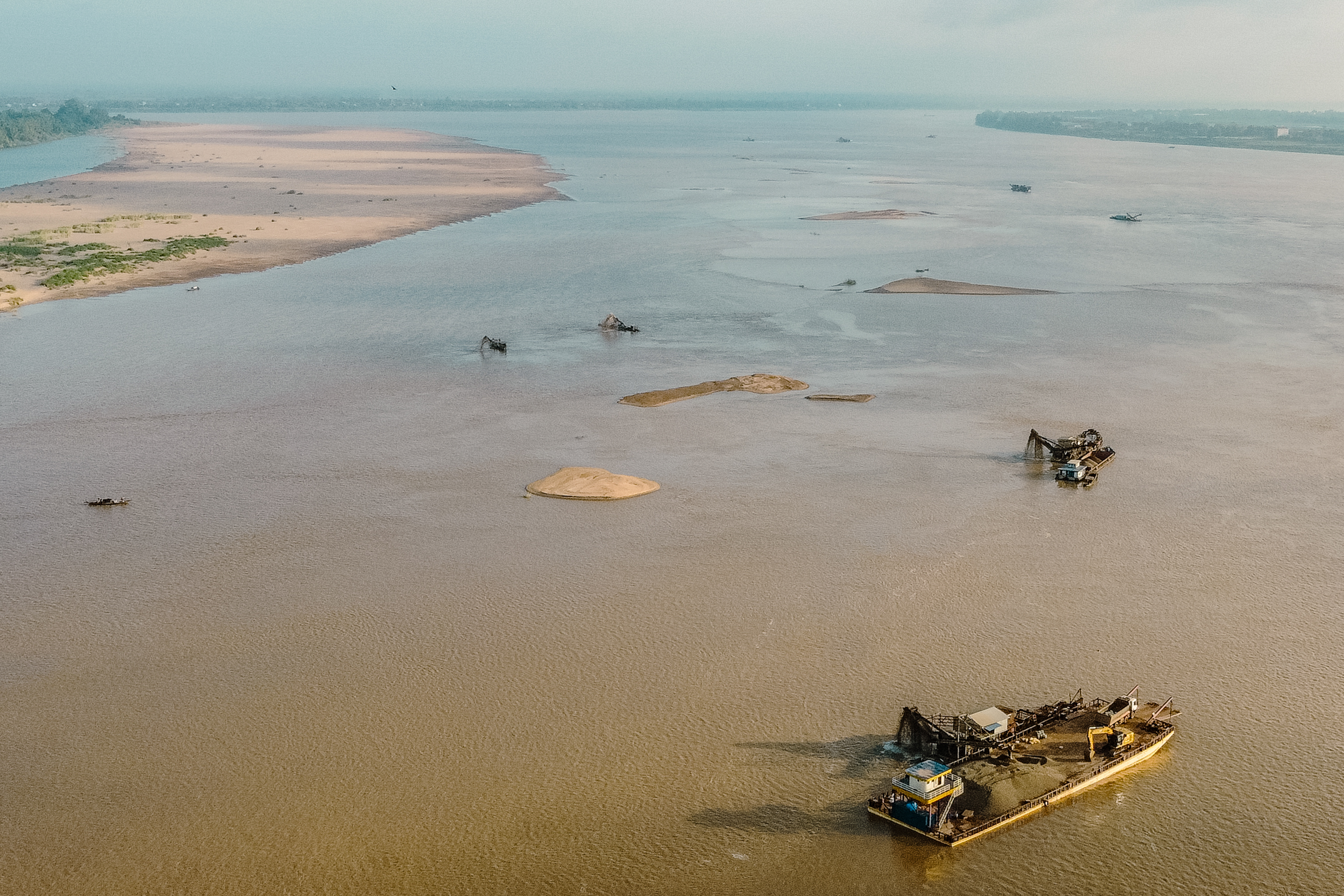
An aerial view of sand mining of the Mekong in Kratie, Cambodia. Although officially banned in Cambodia for being highly destructive to the environment, this valuable sand ends up in cities around Asia for construction projects. Photo by Nicholas Muller.
A Symbol of a Perilous Future
Chun, a boatman from Kampi, Cambodia, has spent his whole life along this stretch of the river making a living as a fisherman. Like many generations before him, he acclimated to the flood-drought cycle of fish migrations with some level of predictability. Although some years were rough, subsequent years would be better. From his small wooden house raised on stilts, he spent his life with the same daily routine: cranking his small boat engine and heading out to the middle of the river for hours, waiting patiently for the big fish he would dependably catch there.
Like clockwork, in large pods around his boat, the revered Mekong Irrawaddy river dolphins that feed in the area’s deep pools would come up for air to greet him. These pools serve as a critical refuge for numerous fish species to “feed and grow, maintaining the integrity and productivity of the ecosystem.” Upriver in Myanmar, the remaining dolphins living there (70), have long been critical to help local fisherman steer herds of fish into their nets, in a practice called “cooperative fishing”.
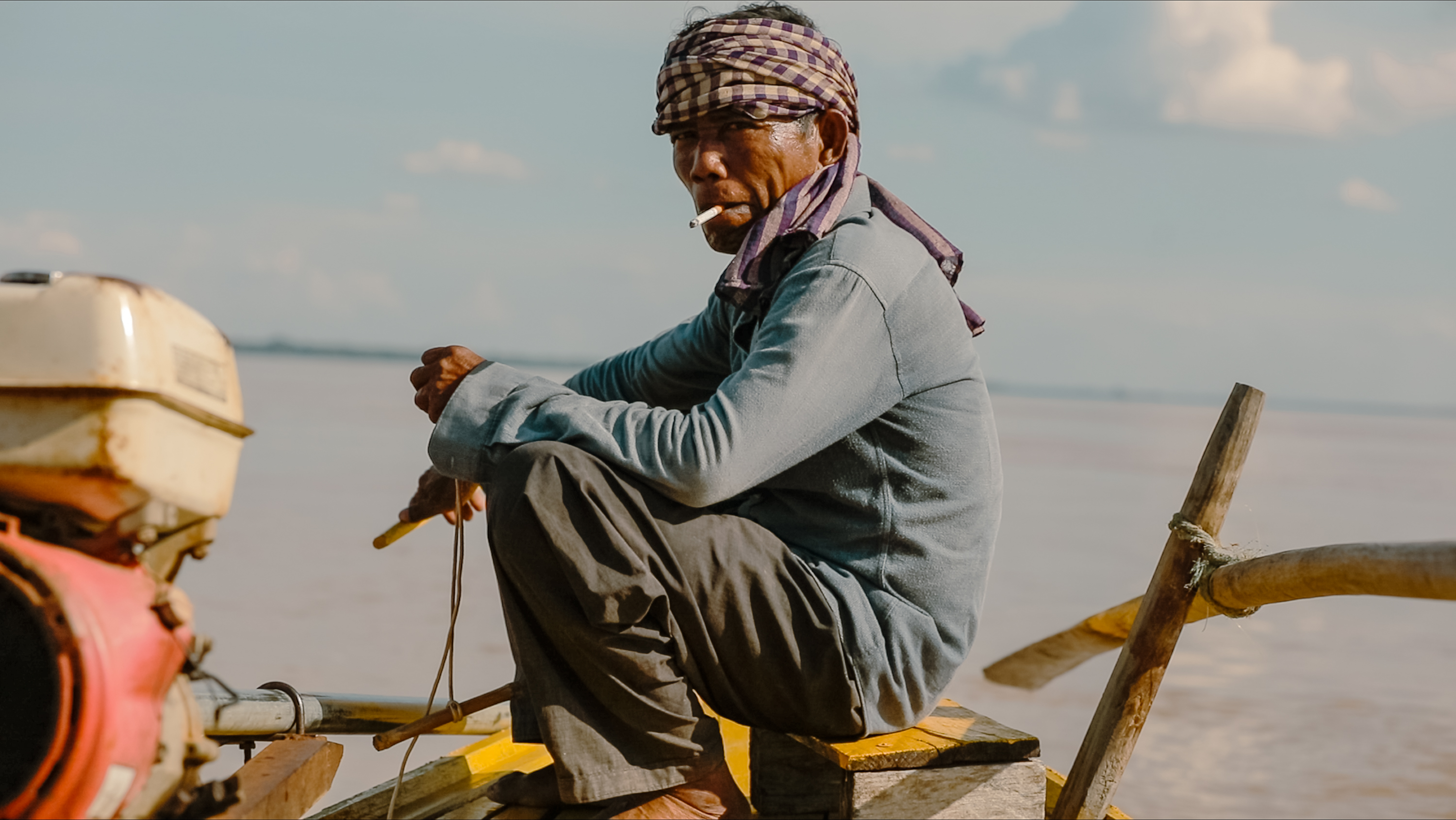
Chun, a seasoned boatman in Kampi, Cambodia. Photo by Nicholas Muller.
Before the pandemic, hordes of tourists would flock to see the river dolphins, boosting Chun’s income, particularly in the dry season. Deemed the “flagship species” for the Mekong’s conservation efforts, the dolphin now serves as a dark symbol of what is transpiring on the Mekong today. The dolphins once thrived throughout the Mekong, but this past February, an Irrawaddy river dolphin died in a transboundary pool between Laos and Cambodia – the last known to be living outside Cambodia’s borders. The World Wide Fund for Nature (WWF) estimates that there are just 92 dolphins left in Cambodia. A new estimate of the country’s remaining dolphin population will be out next year.
Chun’s fish hauls have also declined. Just over a decade ago, the river had yields of 2.3 million tons of fish a year when there were few upstream dams.
“I only catch a few fish now on a good day,” Chun says.
Like his dwindling fish returns, his cherished dolphin days are likely numbered too. “Only a few dolphins I used to see regularly appear. I think there are just dozens of them left,” Chun reckons. The Mekong subspecies are now critically endangered and are under considerable threat by destructive fishing practices in the area.
Chun’s future, like the Irrawaddy dolphin, is tied to things seemingly out of his control and similar to the volatility millions of people and species throughout the Mekong are facing today: increasingly tenuous and unstable livelihoods. The loss feels overwhelming. “We are living season to season now,” Chun says.
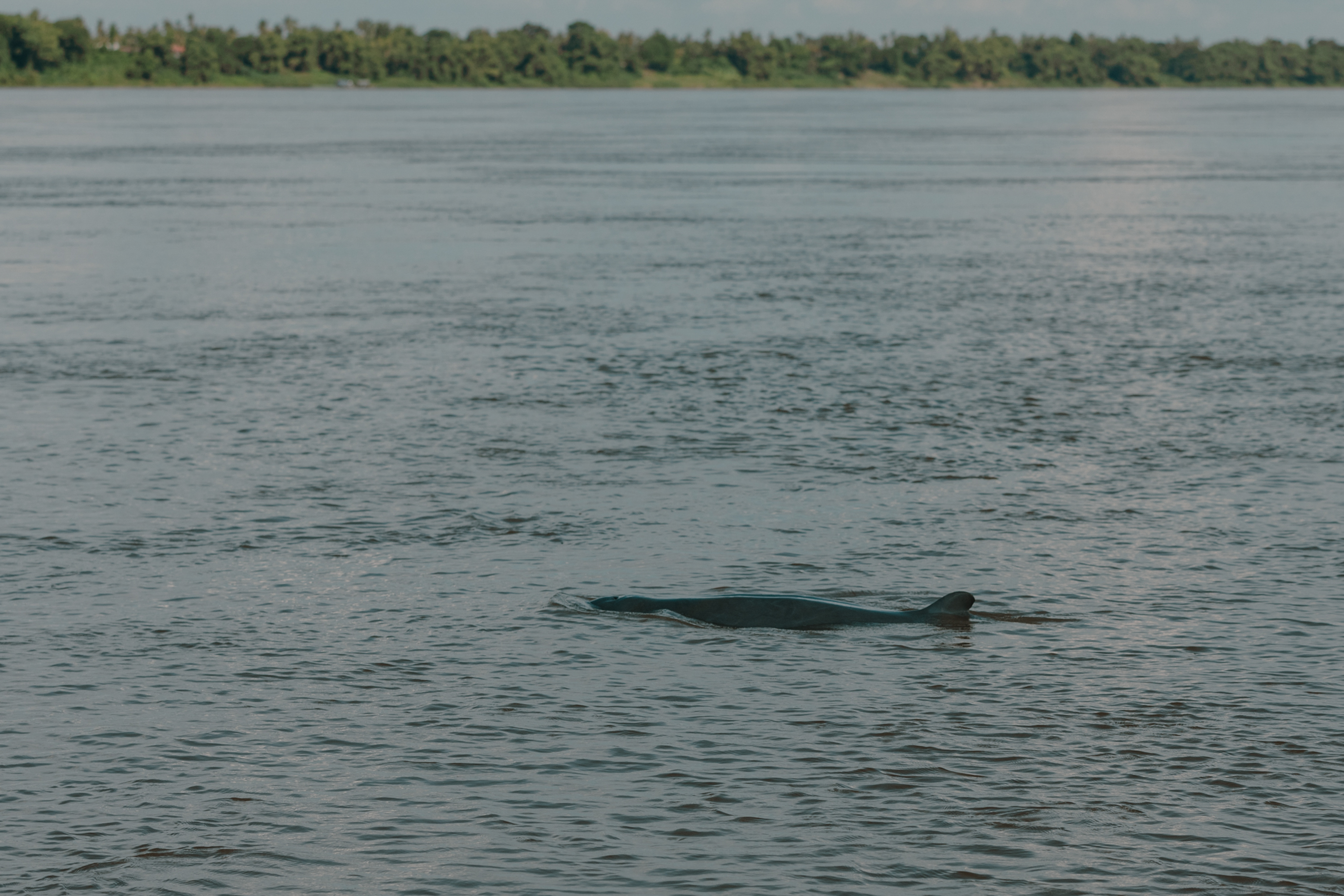
An Irrawaddy dolphin emerging from a deep pool in the middle of the Mekong River in Kampi, Cambodia. Photo by Nicholas Muller.
Climate Invariability, Dam Concerns
It’s been another wild and volatile summer for the Mekong in August and September. “The biggest change in the region since 2019, the basin went through this period of three low-flow wet seasons, mostly caused by climate factors and lack of rain,” Eyler says. The wet season, which normally runs from June to November, has likely been permanently disrupted.
Eyler says the Mekong River Commission (MRC) believes that “rapid river level fluctuations, including due to climatic variability, are becoming the norm. A shift in daily and seasonal flow patterns resulting from water being stored for regional power has disrupted the Mekong’s ecology, putting lives and livelihoods at risk.”
Marc Goichot, WWF’s lead for freshwater in the Asia-Pacific region, told DW he also “attributes the cause of record-low water levels to several factors, including changes of land use and changes in rainfall patterns brought about by the climate crisis.”
New tools at experts’ disposal hope to make it easier to predict and track trends from week to week, and also longer-term trends. The Mekong Dam Monitor tool is an invaluable resource to better understand the big picture in “near-real time” to monitor the dams and environmental impacts throughout the Mekong Basin.
“With the development of the Mekong dam monitor, we discovered that dams are exacerbating low flows and drought conditions during the wet season,” says Eyler. “The string of low-flow wet seasons should be understood as drought: lack of water, lack of resources provided by the natural flow of the river. This means fish migration is down, nutrients that are supported by a high wet season flow through sediment and other transport of nutrients through peak river flow, that’s one of the factors that has been causing a drop in fish population during the last three years and that translates to a lower fish catch.”
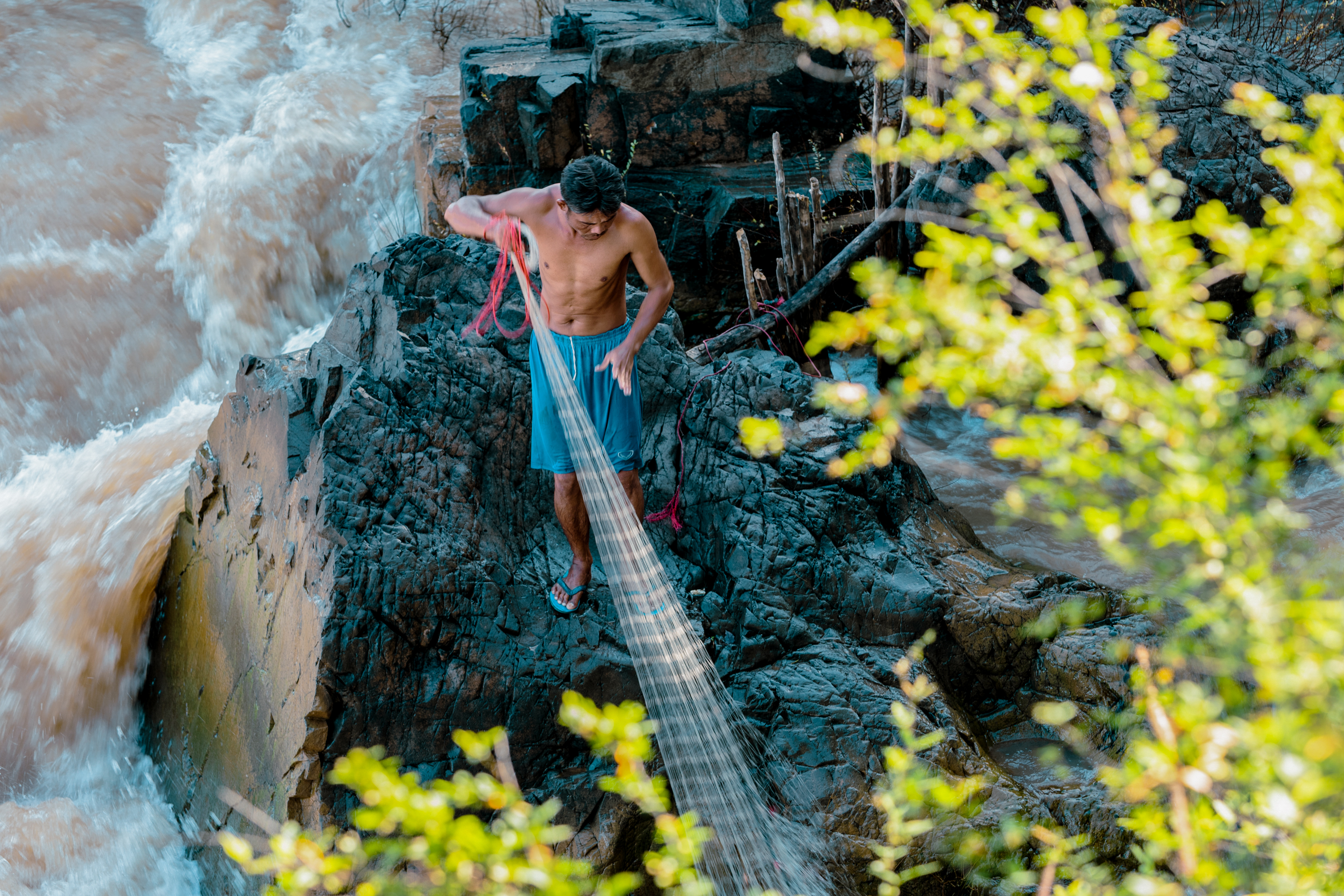
A man casts his net while standing on dangerous rocks to catch fish where the Mekong turns into rapids in southern Laos. Photo by Nicholas Muller.
Ian Baird, director of the Center for Southeast Asia Studies at the University of Wisconsin-Madison, is particularly worried about the cumulative impacts dams are having, particularly on the flooded forests in Stung Treng province, in the northeastern part of Cambodia bordering Laos. “One of the biggest threats to the Mekong right now is too much water in the dry season,” says Baird. “That’s combined with not enough water for the flood pulse, which are related issues. The increasing frequency of wet season drought in the Lower Basin tracks closely to the way China releases water during the dry season and restricts water during the wet season.”
These forests, which are a Ramsar–designated wetlands site, are situated directly on the Mekong and are dying due to dry season upriver dam releases which have serious consequences downstream for forests, fish, and birds dependent on these rich feeding grounds. They are likely the most significant in the entire Mekong Basin and are crucial to the river’s ecology and livelihoods.
“These dams are having a big impact downstream and I think this is why the issue of the flooded forest in Stung Treng is so important because while there’s been a lot of discussion about cumulative impacts of all of these dams. The flooded forest is the most obvious first real clear cumulative impact of these dams and it’s wiping out a whole world-class wetland,” Baird says. “Cambodia can do nothing to mitigate what’s happening in the flooded forests right now. It’s out of their hands and it depends on what Laos and China do.”
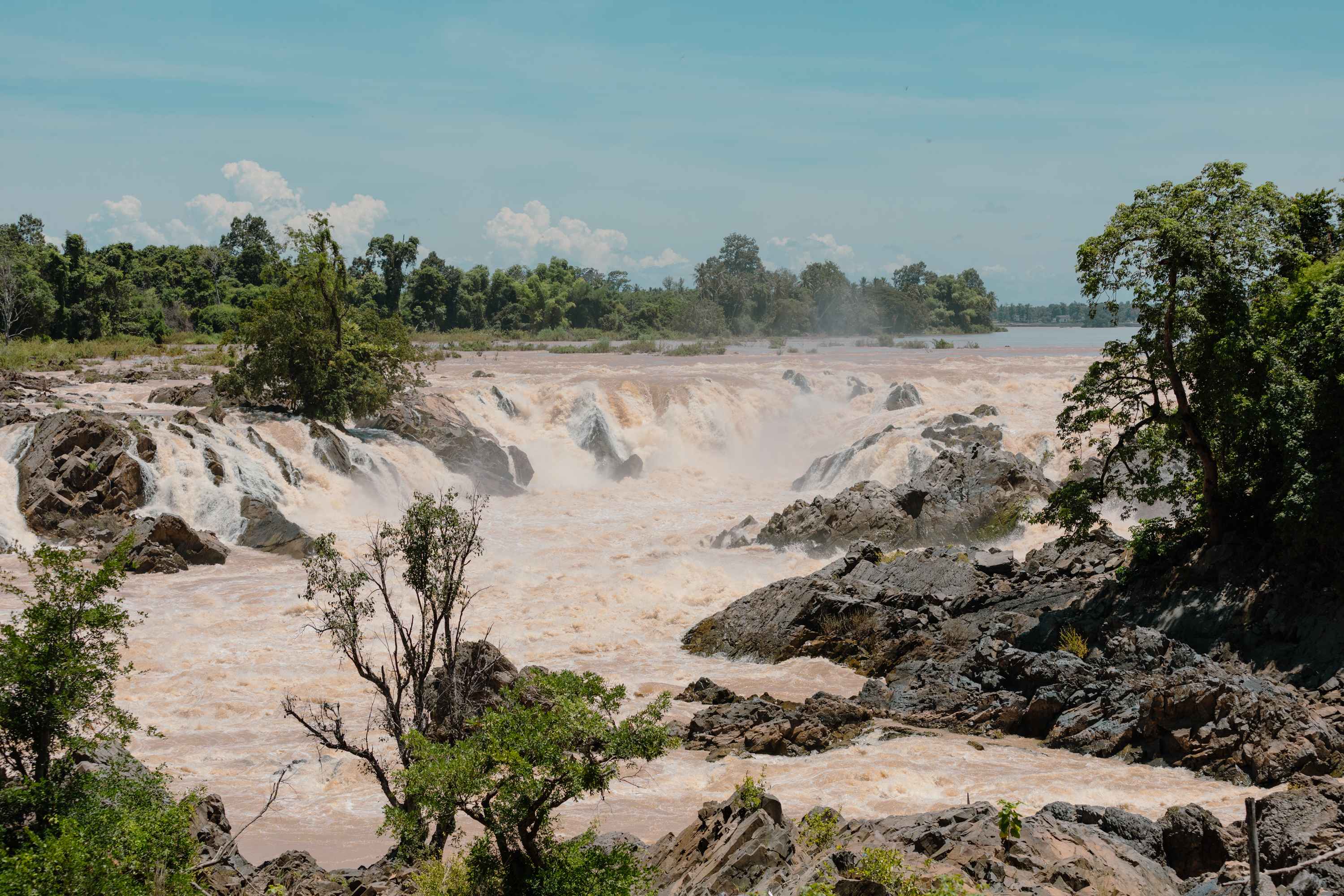
The Khone falls in southern Laos mark the point where the Mekong River turns into rapids in Laos, just north of the Cambodian border. Photo by Nicholas Muller.
In the Tonle Sap, “If we look at MRC data, we can see that this wet season is an improvement over the past three years – but it’s still well below the long-term average in terms of water level and flow volume. This is basically what would be expected, as 2019, 2020, and 2021 were drought years. That we’re still seeing less than average (which measures 1997-2021) also makes sense, as we know upstream dams are changing the hydrology of the Mekong and Tonle Sap rivers, (with a possible reversal),” Abby Seiff, a Tonle Sap expert, says.
Eyler is also worried about another dam on an important Mekong tributary, the Sekong, that he believes is not being talked about enough. “On the Sekong River, which runs parallel to the Mekong mainstream to the east of it on the Lao-Cambodia border, there is a Vietnamese dam being built in Laos on the Cambodian border just upstream from it that would block the migratory pattern of fish from the Sekong River, which is the only remaining free-flowing long tributary of the Mekong,” he says.
If the Sekong dam is completed, Eyler predicts that it would be a game-over scenario and that the small dam would be as impactful as building the larger Stung Treng and Sambor dams planned for the Mekong mainstream. “There needs to be more information provided about that dam because not much has been disclosed,” he says, expressing the hope that the project could be delayed or halted. As of September, Cambodia also appears ready to restart the once-stalled Stung Treng dam project.
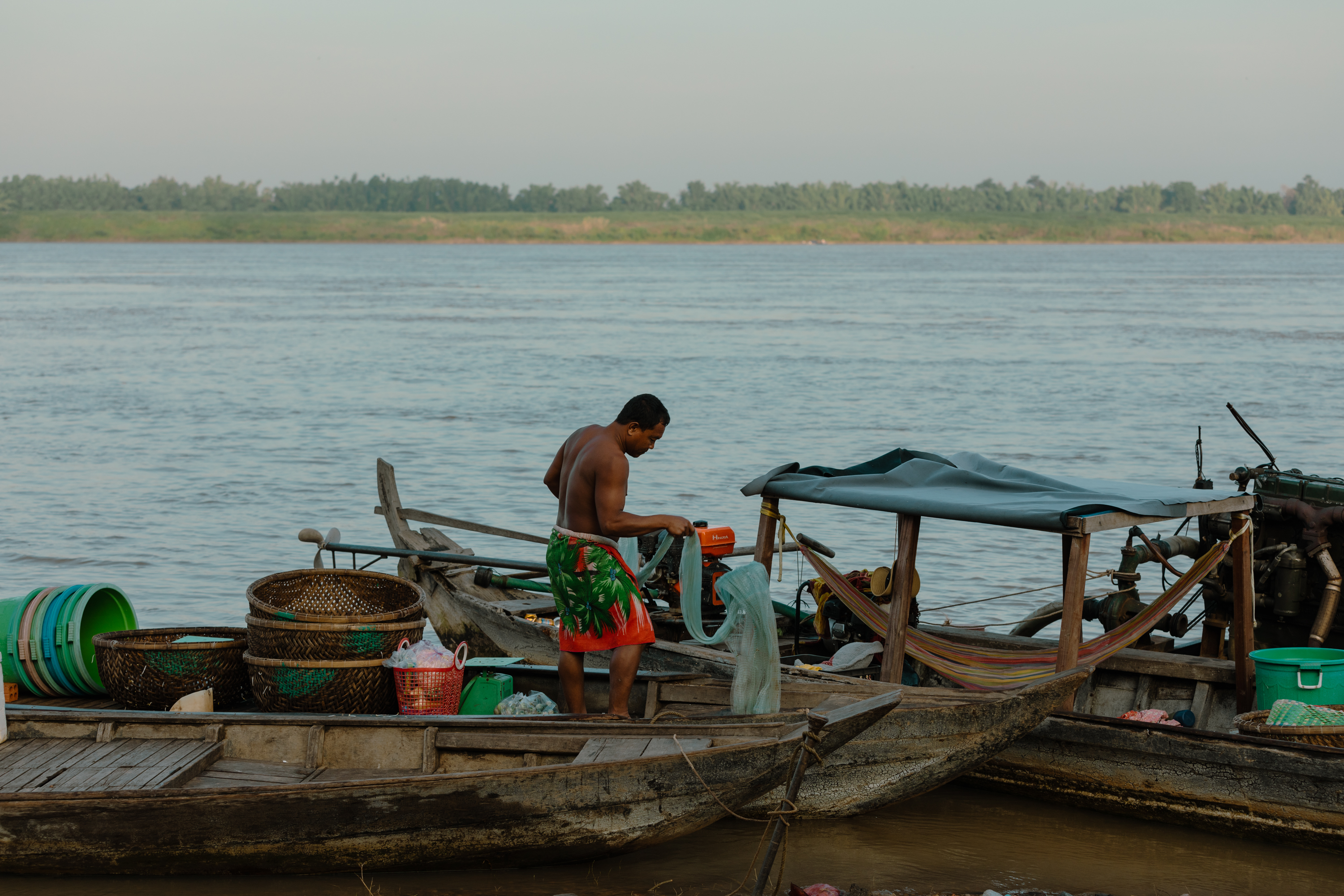
A fisherman untangles his net before going out to more remote areas of the Mekong in Kratie province, Cambodia. Photo by Nicholas Muller.
Mekong Biodiversity at a Critical Juncture
Fishing and farming have long been the mainstays of Mekong communities for generations, and that sense of stability has been tested. Fostering more fish species per unit area than even the Amazon, the Mekong is estimated to provide a habitat for at least 1,100 species of fish. According to the WWF, four out of the top ten giant freshwater fish species still inhabit the Mekong River and it is home to more giant fish species than any other river on the planet. Two of the fish, the giant catfish and the freshwater stingray, have gained mythical status and international renown as the flagship Mekong species. However, they are under constant threat. According to the IUCN, the giant catfish is critically endangered, and the Mekong freshwater stingray is listed as an endangered species.
Dr. Zeb Hogan, a research biologist at the University of Nevada, Reno, says these particular species have a special significance for the Mekong. “These iconic fish are symbolic of the overall health of the river, and losing them is a warning that current safeguards are not adequate to protect biodiversity and fisheries. The threats that the most vulnerable fish face – habitat destruction, changes in river hydrology and spawning cues, and loss of river connectivity – also impact other more common and commercially important fish,” Hogan says.
As the giant catfish and the Mekong freshwater stingray are long-distance migrants, it means the rhythms of their lives are highly dependent on unimpeded access up and down the river. The giant catfish is now increasingly uncommon, with a population decline of at least 50 percent in the last two decades in Thailand alone. The Mekong stingray has also undergone a population reduction of 50–79 percent over the past three generation lengths (45 years).
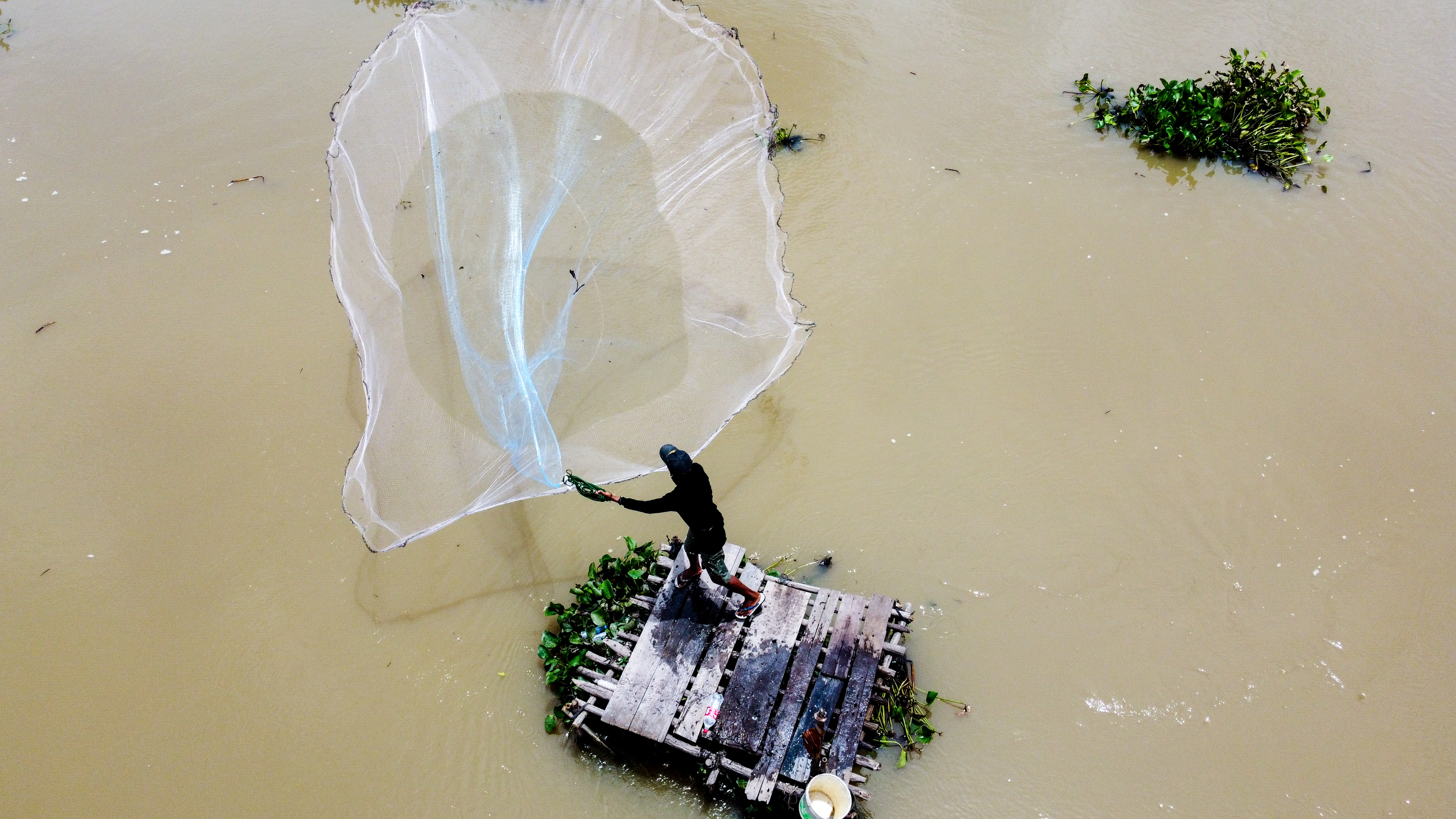
An aerial view of a fisherman casting his net on the Tonle Sap lake, Cambodia. Photo by Nicholas Muller.
“The concern is that the disappearance of the most vulnerable species won’t be the last domino to fall but the first, and that the decline of species like the Irrawaddy dolphin and Mekong giant catfish will be followed by more pervasive environmental problems and could ultimately lead to the collapse of the world’s largest inland fishery,” says Hogan.
In June, Hogan’s team accomplished a historic feat. They caught and release the largest Mekong stingray ever recorded, and possibly the world’s largest freshwater fish, on the small river island of Koh Preah, south of Stung Treng. “More conservation action is needed,” he says. “Many of the Mekong’s most iconic species are at risk of extinction. The presence of this incredible but highly endangered animal, in an area that supports the livelihoods and food security of millions of people, shows plain as day the urgent need for conservation programs and the potential benefits of government, scientists, and local communities coming together to safeguard the wonders of the Mekong.”
Despite these difficulties, Hogan tries to also see some bright spots in the Cambodian section of the Mekong: “A variety of factors define river health: water quality, natural flow regime, connectivity, sediment load, fisheries productivity, and biodiversity status. The Cambodian Mekong remains largely free-flowing, fisheries remain an incredibly important source of nutrition and livelihoods, and iconic species – like the Mekong giant catfish, giant stingray, and Irrawaddy dolphin – persist, despite the challenges they face.”
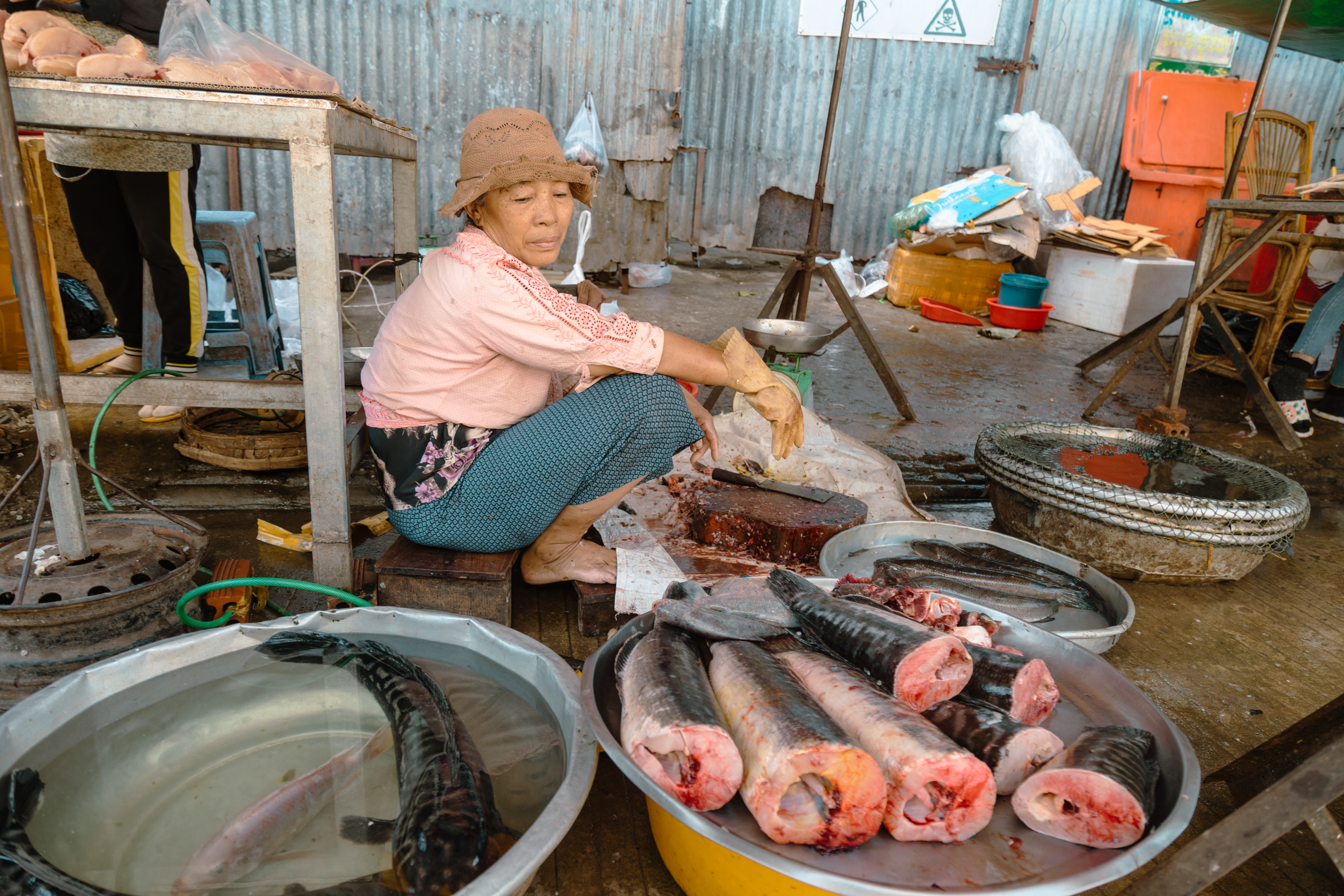
A woman sells fish in the Cambodian city of Kratie. Photo by Nicholas Muller.
China’s Mekong Narrative, Missing Data
In an aggressive effort to sway public opinion, China continues to push falsely positive narratives about the health of the Mekong River. It has been overstating the benefits of dams, hoping to deflect criticism from the damage they have caused, and instead shifting the blame primarily to climate change. “I worry about knee-jerk reactions to things that happen downstream that would align with China’s upstream discourse,” says Eyler.
He says the most common narrative is that Chinese upstream dams are a regional public good by “storing water in the wet season and releasing water in the dry season” for downstream states. “No one downstream is asking for that,” he says.
Downstream countries do not agree with China’s narrative about the river.
“Although the impact of climate change in the Mekong basin has been well-documented, overemphasis on this factor runs the risk of obscuring and even whitewashing the controversy over Mekong hydropower development,” says Eyler. “China’s unilaterally imposed narratives that obscure the full, complex picture is part of the problem, not the remedy.”
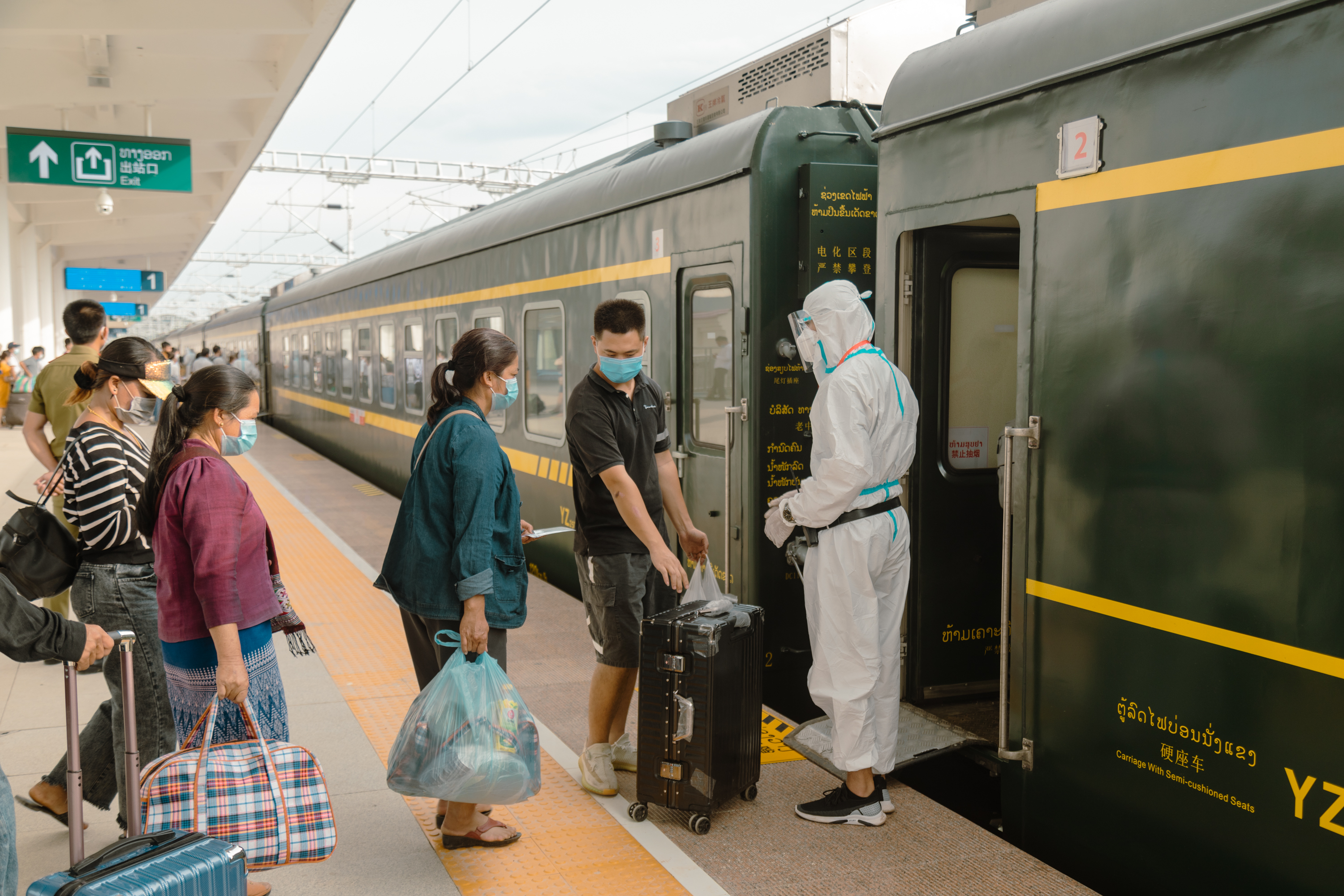
Passengers board the new Laos-China railway in Boten, northern Laos. The new train connects Kunming, China to Luang Prabang and the Lao capital Vientiane and has dramatically altered the connectivity and physical geography of northern Laos. Photo by Nicholas Muller.
This year, there have been some glimmers of progress. China has started to pledge more information sharing and more cooperation downstream, which began before the Mekong Dam Monitor (MDM).
Eyler says that now that the MDM is operational, and the MRC has a lot more information about how the major dams in the system are operated, the Chinese have been increasing their pledges for data sharing and increasing cooperation on joint studies on the future management of the river at increasing frequency. “All Mekong countries face these trade-offs and have a share of responsibility over the state of the river. Therefore, the cure for the dying Mekong must begin with clinical analysis and honest exchange among river states,” Eyler says.
To fill the information gap, Eyler says the MDM is providing information on China’s dams, and the largest dams in the system. “But there’s nothing better than the real thing, so China needs to provide its information too downstream to fill the critical gap with real physical data rather than data that is estimated through satellite remote sensing techniques,” he adds. “We think that our efforts paint a fuller picture, but it’s not. And a perfect picture can be painted with better cooperation with China.”
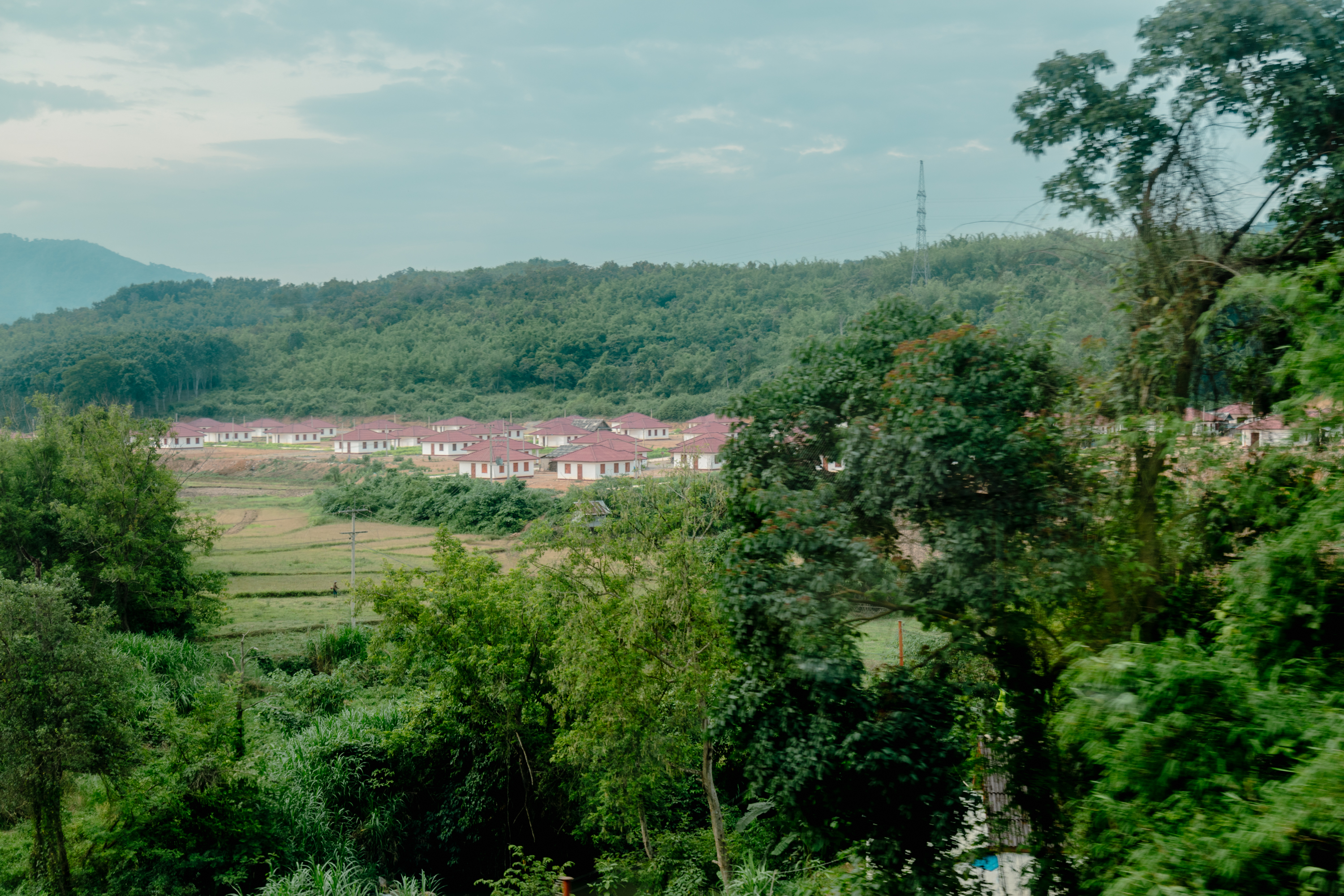
Homes built for people displaced by Chinese construction projects in northern Laos. It is often difficult for people in communities to work properly without access to farmland or to the Mekong they once had. Photo by Nicholas Muller.
Thailand’s Golden Triangle: Chiang Saen and Chiang Khong
Chiang Saen, in the heart of the Golden Triangle where the three countries meet, sits at an important crossroads for the Mekong. The area serves as a key gauge for the entire lower Mekong basin facing Laos. “Using 1992-2019 satellite data and daily river height gauge data from Chiang Saen, Thailand, the April 2020 Eyes on Earth report highlighted the connection between the unprecedented drought during the wet season in the Lower Mekong in 2019 and Chinese upstream dams’ restriction of a large amount of water to prioritize the selling of hydropower,” Eyler says.
This year, data suggests that a lot of water is still missing from Chiang Saen because of dams. According to Eyes on Earth, “there should still be 50 percent more water in the river than is currently observed.”
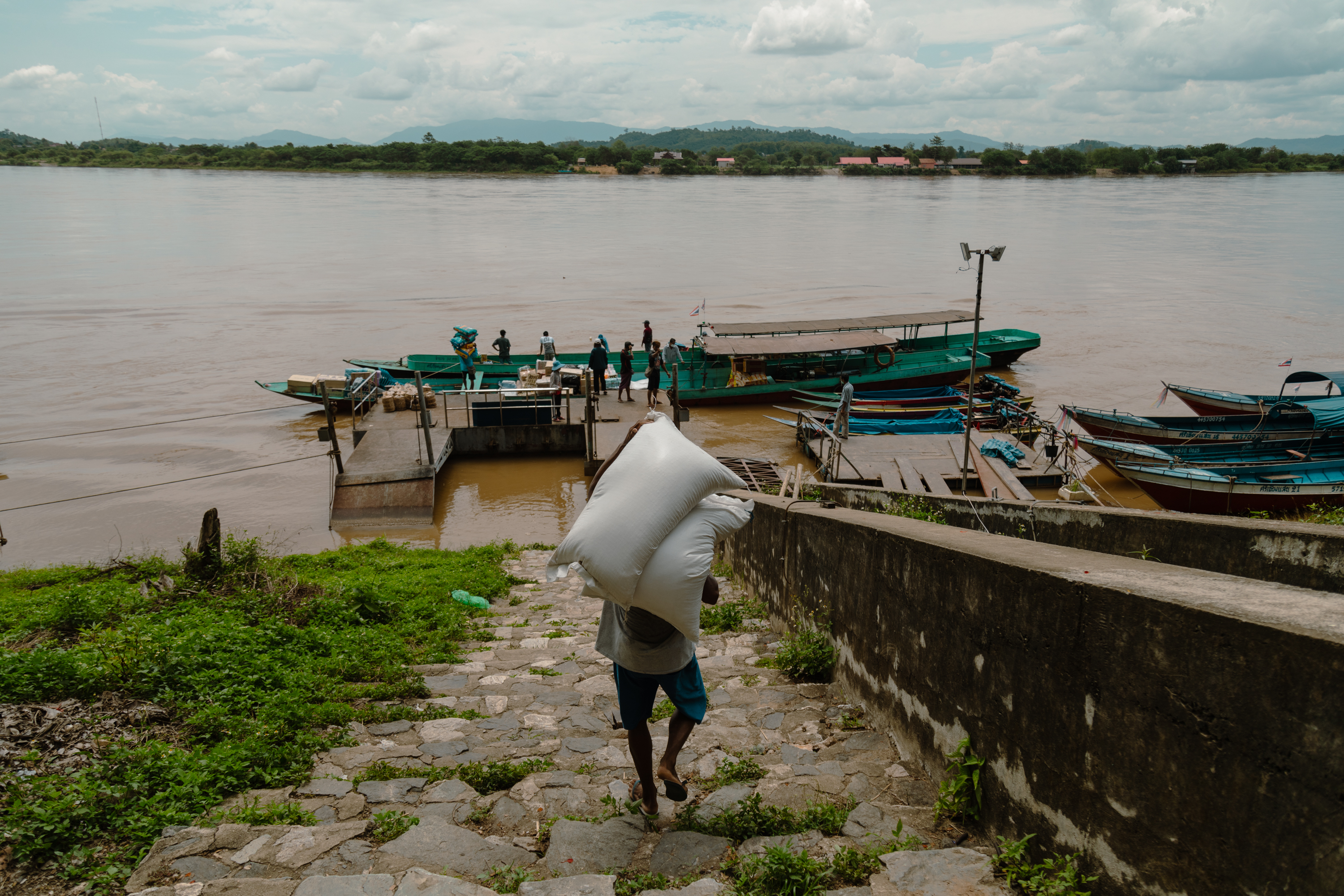
At a small port in Chiang Saen, Thailand in the northern triangle, fishermen bring goods to other parts of the river and to Laos. Photo by Nicholas Muller.
The consequences on this stretch of river have taken a hefty toll: populations of the famous Mekong giant catfish have plummeted by over 50 percent in just two decades. This is nowhere more evident than in Chiang Khong, where some of the deepest pools in the entire Mekong exist for catfish to spawn. The legendary catfish is regarded with veneration in Thai culture. Its prolific days are gone, however, and climate events have exacerbated hardships for people here. “2019, 2020, and 2021 were really difficult years with drought and we rarely see those fish anymore,” a local fisherman tells The Diplomat.
While some on the Mekong feel powerless to affect change along their stretch of the river, Eyler says that there are pockets of successful resistance to dams and mega-construction projects and that Thailand is most tuned into community interests. “You see official announcements by Thai water authorities about the environmental impacts of mainstream Mekong dams that could be built in Laos and in China on community fisheries and livelihoods, particularly along the Thai-Lao border,” he says.
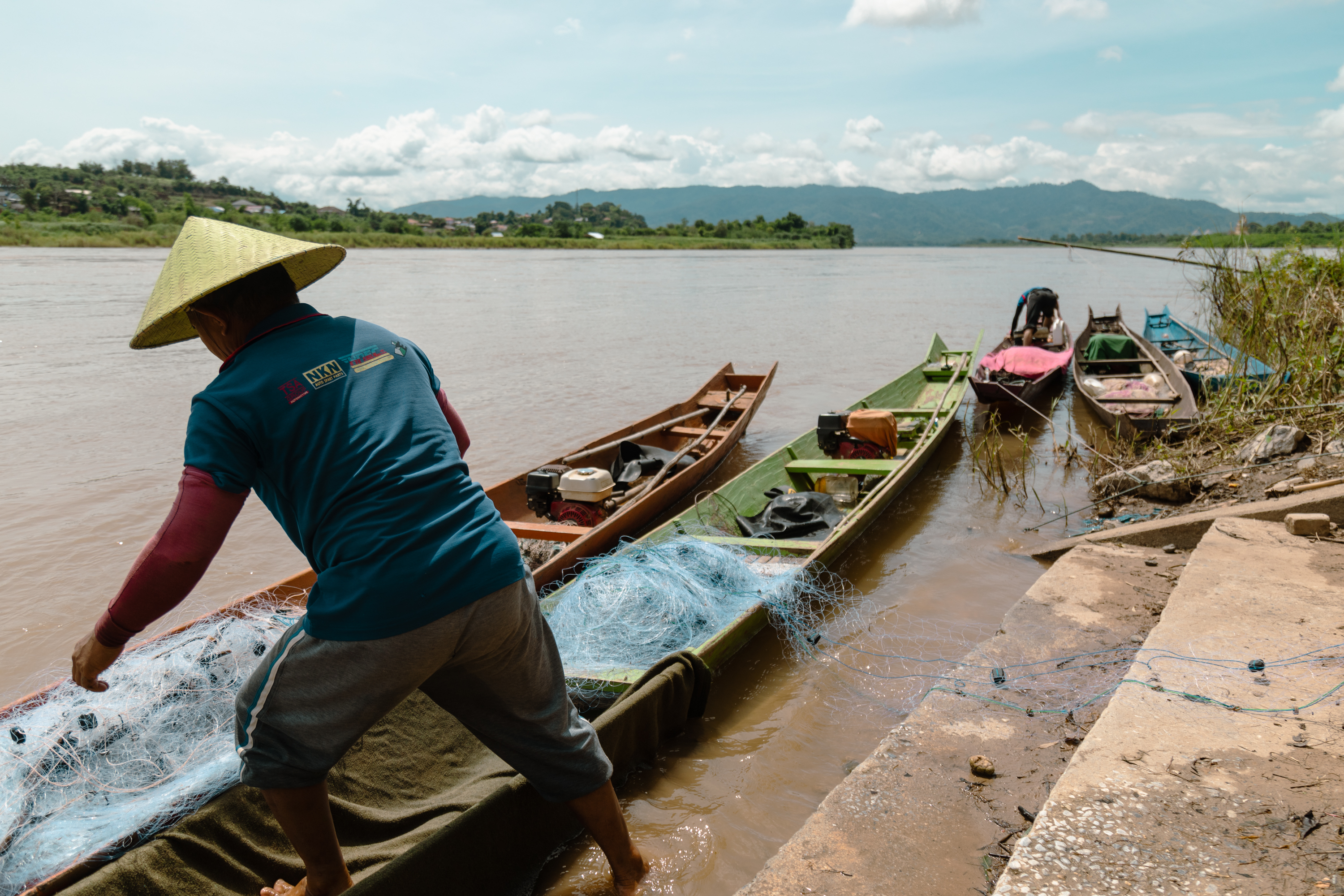
A fisherman on the Mekong River in Chiang Khong, Thailand, a stretch of the river famous for its Mekong Giant Catfish. Photo by Nicholas Muller.
“We heard about dams being built upstream and began to see changes. Before, there was no poverty along the Mekong River. We could fish to support ourselves, and planted many different crops in the rich soil, in the past giant fish would come to lay their eggs and spawn. The main cause for the loss of the fish catch has been the dams upriver,” said Niwat Roykaew, in an interview after winning the 2022 Goldman Environmental Prize.
As a school teacher turned activist from Chiang Khong, Niwat says people are now struggling to farm in the area. The advocacy of Niwat and Mekong communities resulted in the termination of the China-led Upper Mekong River rapids blasting project, which would have destroyed around 400 kilometers of the Mekong to deepen navigation channels for Chinese cargo ships traveling downstream.
However, not all battles are won: In August, a Thai court dismissed a lawsuit involving the company which built the Xayaburi dam.

New Chinese construction projects in once remote areas of northern Laos are dramatically transforming the region. Photo by Nicholas Muller.
Diverging Climate Priorities, Food Security Worries
According to Eyler, “It is inevitable that the Mekong region will feel the impacts of climate change through water, including food insecurity, and will affect livelihoods through poverty and increased out-migration. It will become exponentially harder as climate impacts become more severe, which they are expected to do. However, these countries have diverging priorities and immediate concerns.”
Laos is a black sheep among the four countries. Eyler says that its government doesn’t articulate many of the concerns other Mekong countries have expressed about activities along the Mekong. “They are concerned about dam safety, and managing this battery of dams they have now effectively will bring more income. There is really a divergence in terms of prioritization of Mekong water resources utilization and exploitation in Laos compared to the other three countries,” he says.
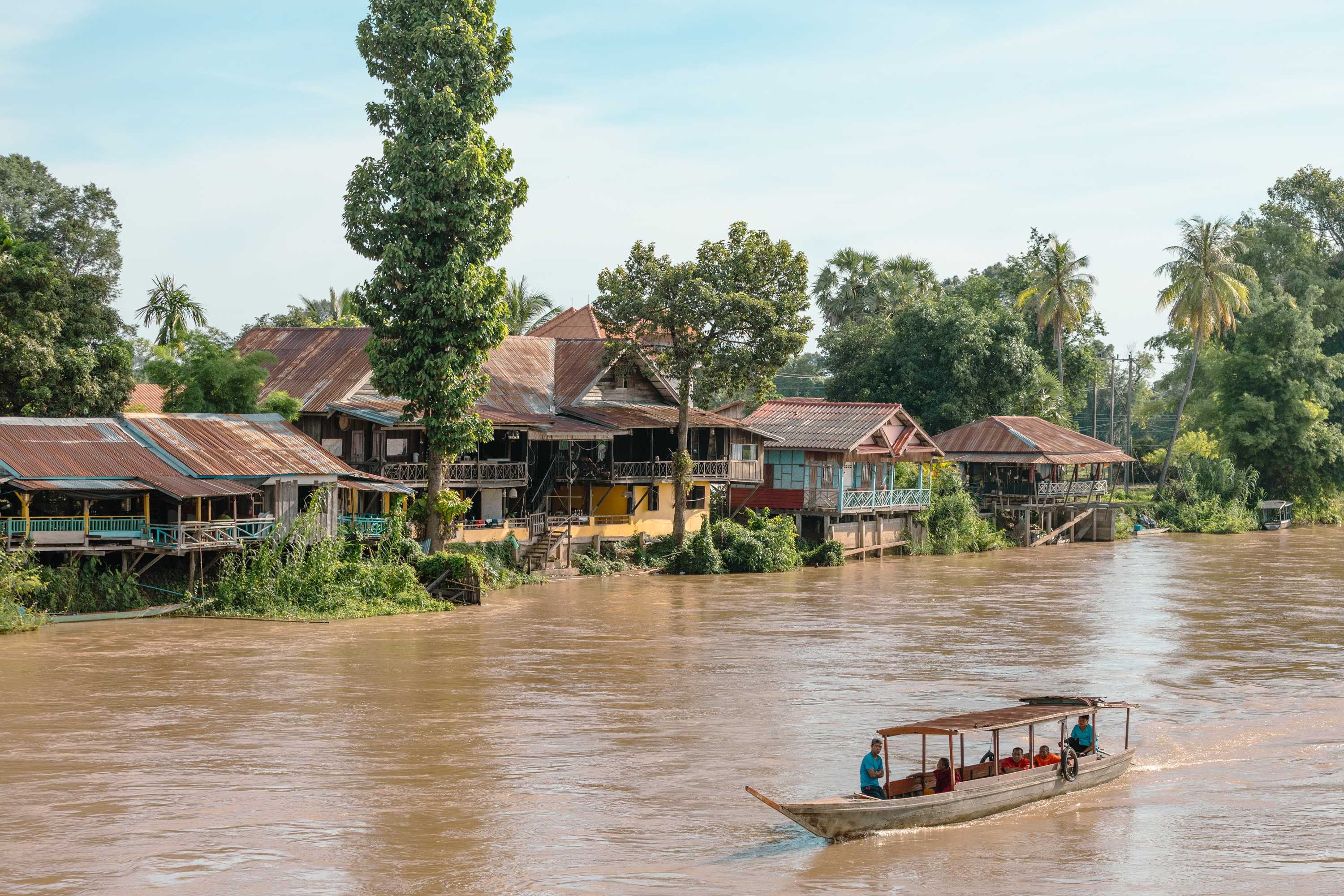
Monks commute to a temple in Si Phan Don, southern Laos. Photo by Nicholas Muller.
Regarding Vietnam, the approach is different.“Vietnam’s concerns are about the Mekong delta, so you bring in more climate change impacts and the viability of the delta to be a viable tangible space in a century from now,” Eyler says. There are more immediate concerns that are fisheries-related and related to riverbank collapse. “There is so much riverbank in the delta now that is falling into the river and people’s homes are being destroyed. This set of concerns seems to be focused on preserving the land integrity, water quality, and productivity of the delta,” he says.
The long-fruitful delta, called by some Asia’s rice bowl, provides for 90 percent of Vietnam’s rice exports and is an essential sanctuary for numerous fish species which are under threat. According to an article in Science, “Owing to only a few decades of human influence and unsustainable management of the Mekong River basin’s natural resources, the Mekong Delta is receding rapidly. Most of the delta landform, home to 17 million people and an economic powerhouse, could slip below sea level by 2100.”
Today, it is one of the most at-risk deltas in the world, particularly susceptible to climate change. The challenges facing the Mekong Delta are acute: subsidence and continually extracted groundwater are significant threats, reducing flood water storage capacity in the Mekong Delta. In early October, reports in Can Tho showed catastrophic flooding.
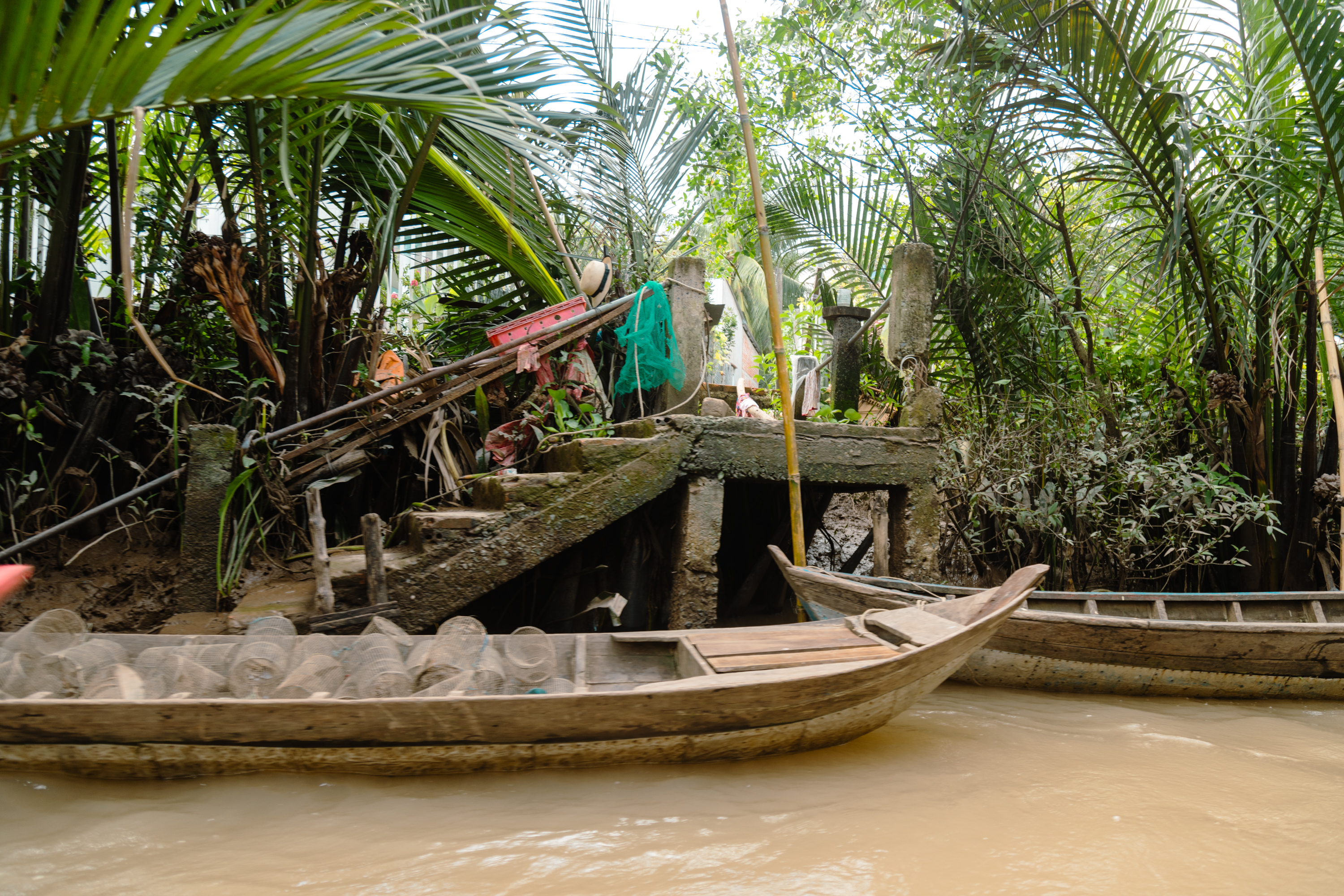
In the Mekong Delta, land subsidence is making life harder for farmers and residents causing many to migrate to bigger cities. Photo by Nicholas Muller.
Delta Outmigration
Over decades, dimming prospects in the delta have forced waves of primarily young people to Ho Chi Minh City (now with a population of more than 9 million) and to other urban areas in Vietnam. Eyler expects this trend to continue. “There are already too many people living in the delta, and they were moved there through forced migration programs by the French, the Americans, and by the current government for a variety of functions and purposes,” he says. The heavy stress on the delta’s landscape has made it more densely populated than any other part of the Mekong.
Vietnam is aware of the seriousness of the problem it faces. The significant outmigration from the delta, particularly over the last decade, is an anomaly in a country that has experienced rapid urban population growth. Life is becoming much harder for large parts of the delta for several reasons: farmland is worsening or becoming unfarmable because of saltwater intrusion in coastal zones and heavy pollution, along with major water deficits. Farmers often have to take on heavy debts to keep their livelihoods, but many endlessly are sinking into debt like the land itself is sinking into the sea.
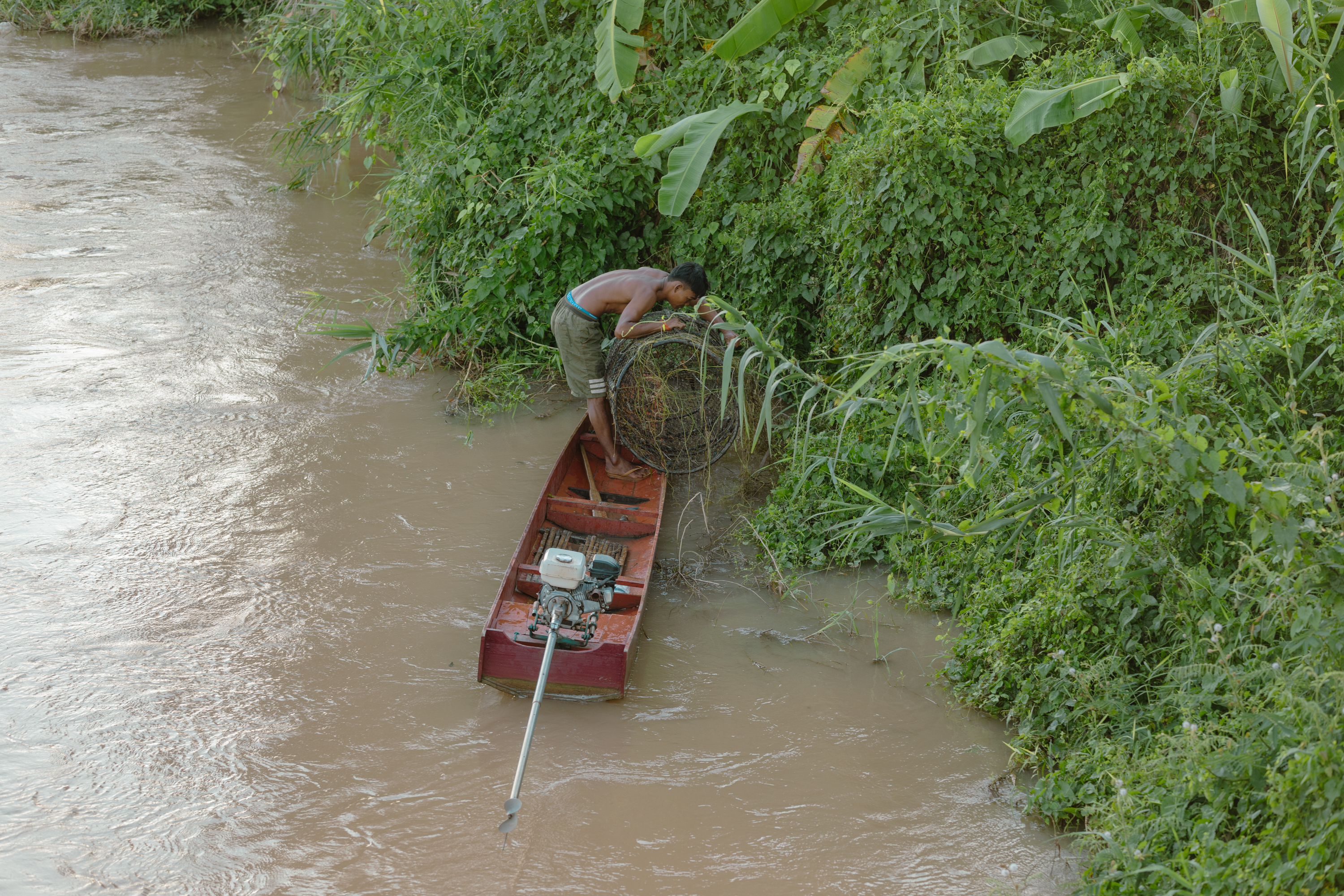
A fisherman in Si Phan Don, southern Laos, collects his fish at the end of the day from a trap set up. Photo by Nicholas Muller.
Poor water quality is a growing problem in the Mekong, acutely in the water-stressed delta. According to a 2020 U.N. Water report, climate change is expected to “exacerbate water quality degradation as a result of higher water temperatures, and reduced dissolved oxygen content causing a reduction in the self-purifying capacity of freshwater bodies.” It adds, “there are further risks of water pollution and pathogenic contamination caused by flooding or by higher pollutant concentrations during drought.”
“The impacts of dams and poor planning that are happening in the delta right now are pushing against the time frame that the Vietnamese have to adapt. It is the storm surge that will happen more and more, that’s going to affect the sinking city,” says Eyler. “These tides are going to push farther and farther inland until the storm breaks the coastal barriers into the city, and then water sticks around for a long time.”
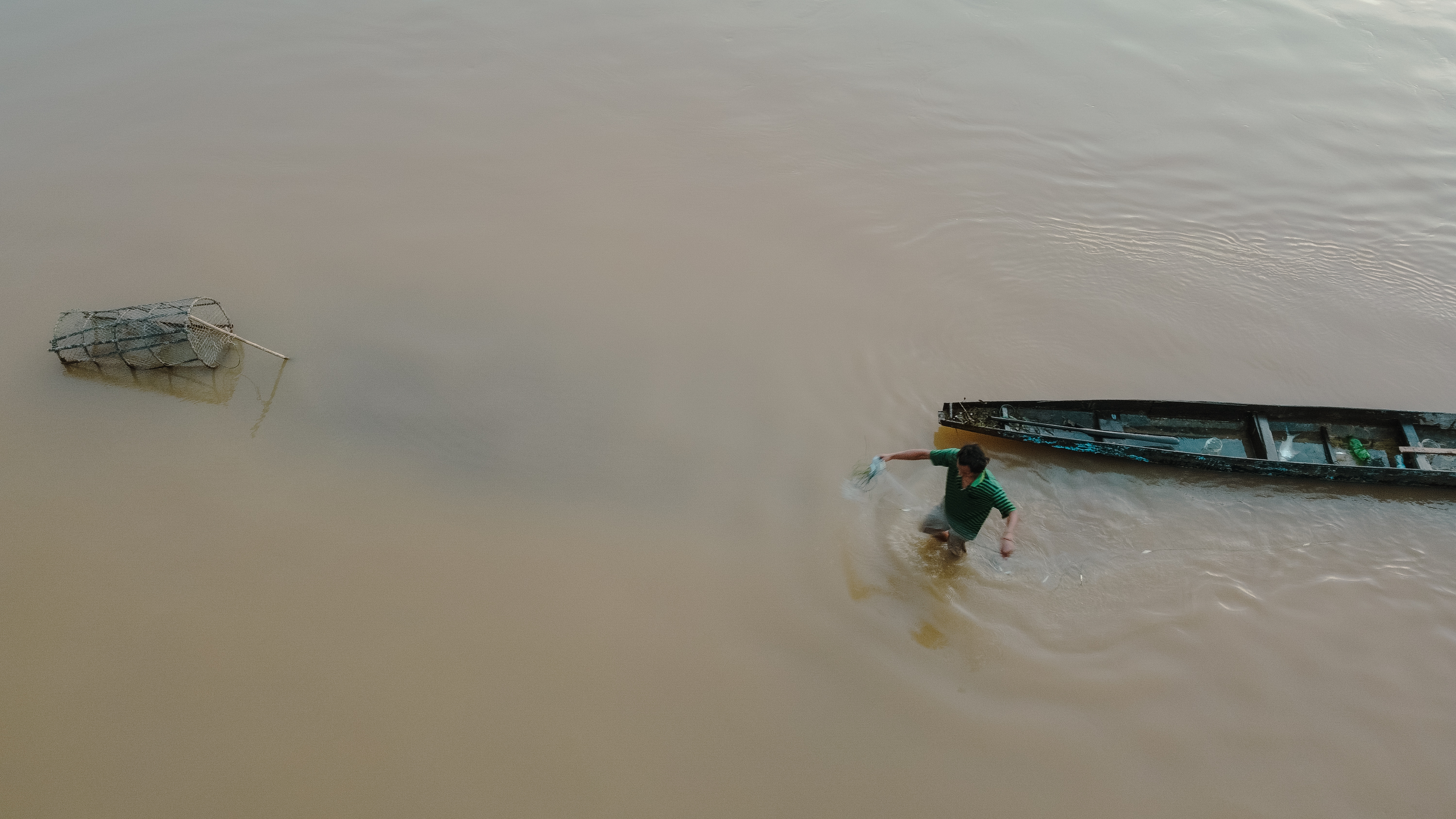
A man fishes with his trap on the Mekong River. Photo by Nicholas Muller.
Those that stay in the Mekong Delta, including many older Vietnamese, will have no choice but to adapt their lives and their farming methods to produce higher-value agriculture. Eyler sees some promise in pilot projects and some transitions happening like vertical farming, which will produce temperate vegetables in the delta, and chocolate production. “There is time to manage this, the delta won’t disappear in 20 years, so there is probably a century to work on this and promote a transition and so thankfully the Vietnamese have that on their side,” he says.
In September, according to a U.S. State Department press release, Special Presidential Envoy for Climate John Kerry visited Vietnam and met with Prime Minister Pham Minh Chinh “on cooperation on combating the climate crisis as a pillar of the relationship.” Kerry said, “The United States is committed to working with G7 countries and others to support an ambitious and just energy transition and climate change adaptation in Viet Nam.”
More recently, on November 20, after the APEC summit in Bangkok, the U.S. announced new funding for new clean energy projects and other economic development initiatives (JUMPP) for the Mekong region. Vice President Kamala Harris said, “In particular we know that the climate crisis presents a real threat to the communities who depend on the Mekong River. In Thailand, in Vietnam, Laos.”

A displaced fisherman in Pak Ou, Laos, where the Mekong and Nam Ou Rivers meet. The Nam Ou 3 dam is nearby. Photo by Nicholas Muller.
Cambodia’s Food Insecurity Worries
Eyler sees that Cambodians and Vietnamese are prioritizing food security on their list of Mekong issues especially because of the importance of rice exports to the region and the rest of the world. According to the World Bank, the production of rice, Cambodia’s main crop, accounting for close to 60 percent of agricultural GDP, rose by 9.3 percent during the 2021‒22 rice production year, reaching 12.2 million metric tons.
“In Cambodia, the focus is on the Tonle Sap and the fisheries and keeping them robust because of the food security concern. If the Tonle Sap fishery fails there, so will the Cambodian state, and there will be a severe food crisis that breaks out there. So there is a high political incentive to act wisely on the [Tonle Sap], and Cambodia has a big incentive to work on Mekong fishery issues,” he says.
Eyler currently doesn’t see much political will to engage with Laos or China in a smarter way for dams to be operated.
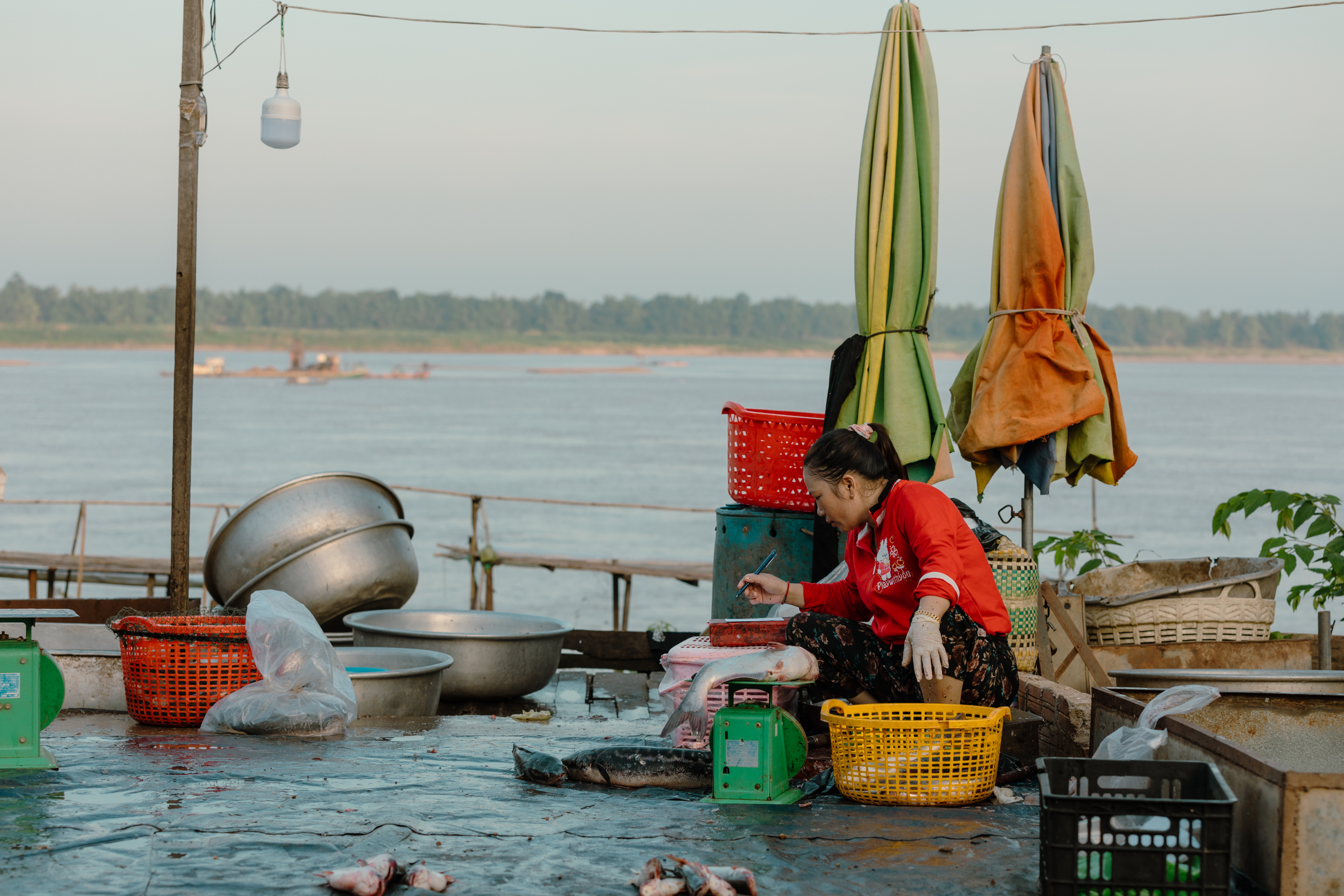
A woman weighs her fish at the early morning market in Kratie, Cambodia. Photo by Nicholas Muller.
At the beginning of August, sounding the alarm, the United States announced it would provide Cambodia with $25 million in agriculture aid to help alleviate global food insecurity worsened by the war in Ukraine, and to prevent a future food crisis.
“If this season had been like the previous three, then the tipping point would either be close or past it. The Mekong ecosystem has resilience, it can bounce back under an uninterrupted state. But given the impacts of dams, and how they are affecting fish migration and sediment distribution, the Mekong has lost its resilience and its ability to recover from these tough past periods. If there would have been a fourth or the fifth low wet season, then we get closer to that breaking point, closer to the point of a food crisis,” said Eyler.
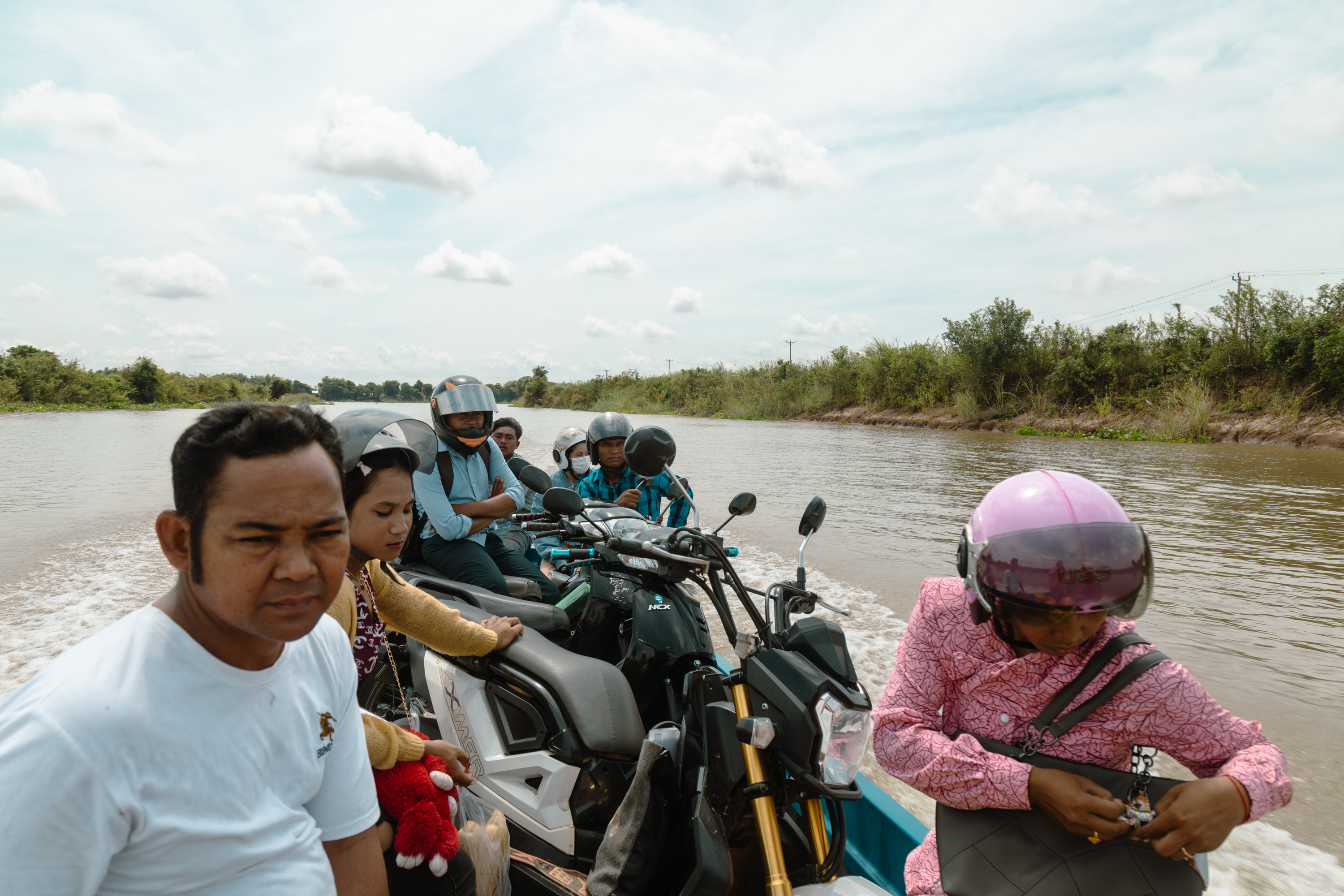
Tonle Sap residents commute on the lake, which connects more remote areas to bigger towns and the capital Phnom Penh. Photo by Nicholas Muller.
A “Beating Heart on Life Support”
Abby Seiff, an expert on the Tonle Sap, says that the effects of hydropower, combined with climate change and overfishing, have been “devastating” for dependent fishing communities. The natural flow of the river is inhibited, and Tonle Sap’s “heartbeat” slows, causing unpredictable effects in the wet season. According to Eyler, “essentially the wider it expands, the higher the levels are, the more fish are going to come out of it, and it has been on ‘life support’ for the last three wet seasons.”
Like in the Mekong Delta, Seiff says the harsher difficulties for people living around the Tonle Sap have pushed people into increasing desperation to search for work further afield.
“There’s not a lot of comprehensive data, but we know that when people can’t catch enough fish to live off they turn to various coping mechanisms: taking on debt, pulling kids from school, going to work in factories or construction sites, or taking on particularly risky, illegal migrant work in Thailand,” she says. “But when fishers are being pushed into this situation, they’re typically taking on riskier, lower-paid jobs — not things being pursued because they represent better opportunity but simply because there’s no other choice.”
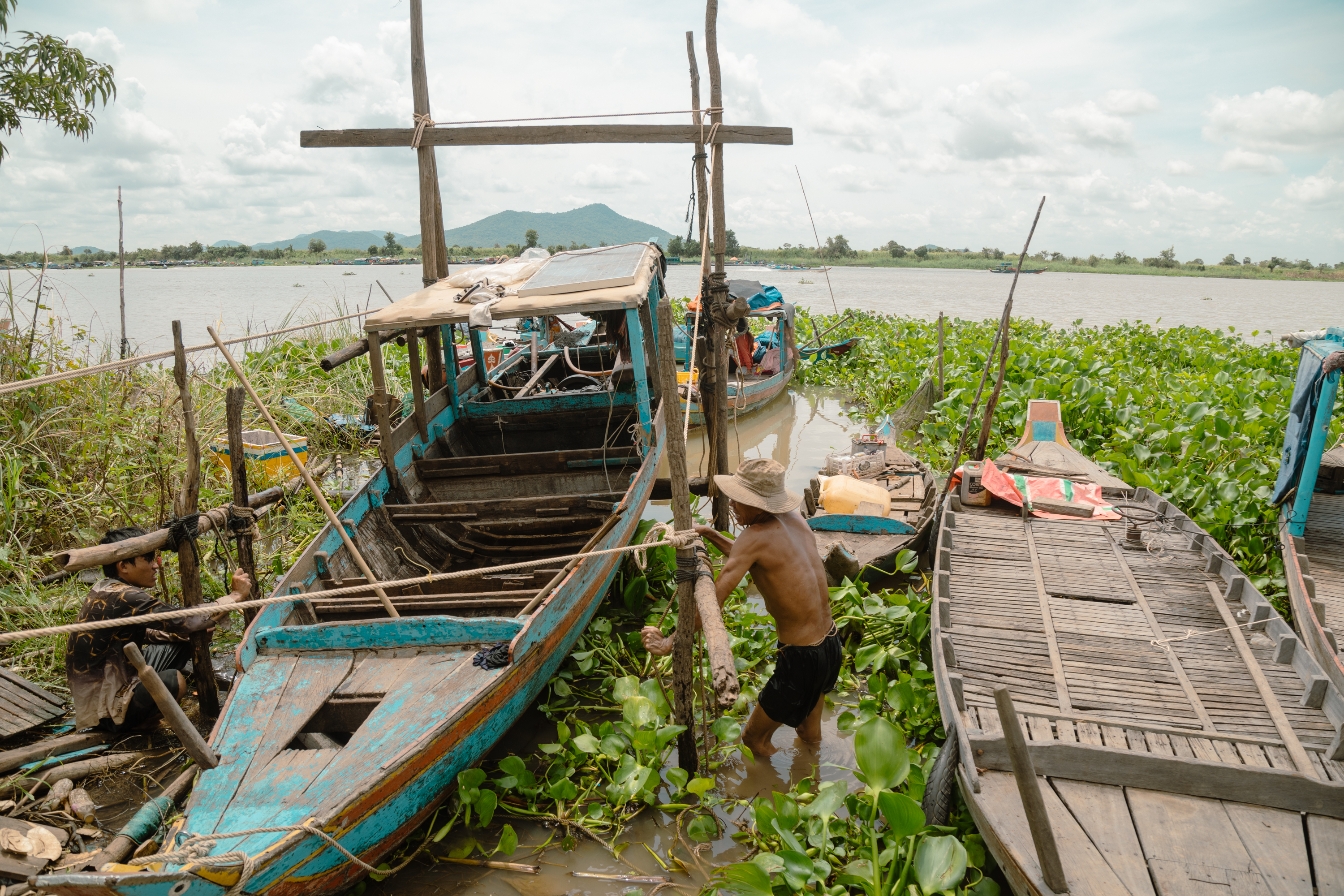
A fisherman secures his boat on the Tonle Sap Lake, Cambodia. Photo by Nicholas Muller.
“When we talk about mitigating the impacts of what’s happening to the lake: This year there was a major crackdown on illegal fishing – in theory, this type of action is positive and quite possibly what’s needed to restore fish stocks. But in practice, it’s just depriving the poorest of their sole livelihood source,” Seiff says.
Lake Stress, Debt Stress
Eyler says that noticeable debt stress has become extremely high around the Tonle Sap while catches have been lower than usual in these last low-flow years which means that those who rely on the Tonle Sap fishery and income, which is millions of people along the shoreline and in floating homes. Subsequently, their livelihoods have become extremely stressed, and take on more debt.
He sees there are positive indications from the Cambodian government that they are taking a comprehensive approach to protect the Tonle Sap and believes the objective is for the lake population to restore itself after three years of stress.
“In a concerted effort to improve conditions, the lake was closed this wet season, to the detriment of those dependent on it. The data that I have reflects that. There is an all-out government effort going on to curb large-scale fishing with rangers from the ministry of environment, and fishery enforcement agencies, all working together to keep illegal fishing from happening along the lake,” he says.
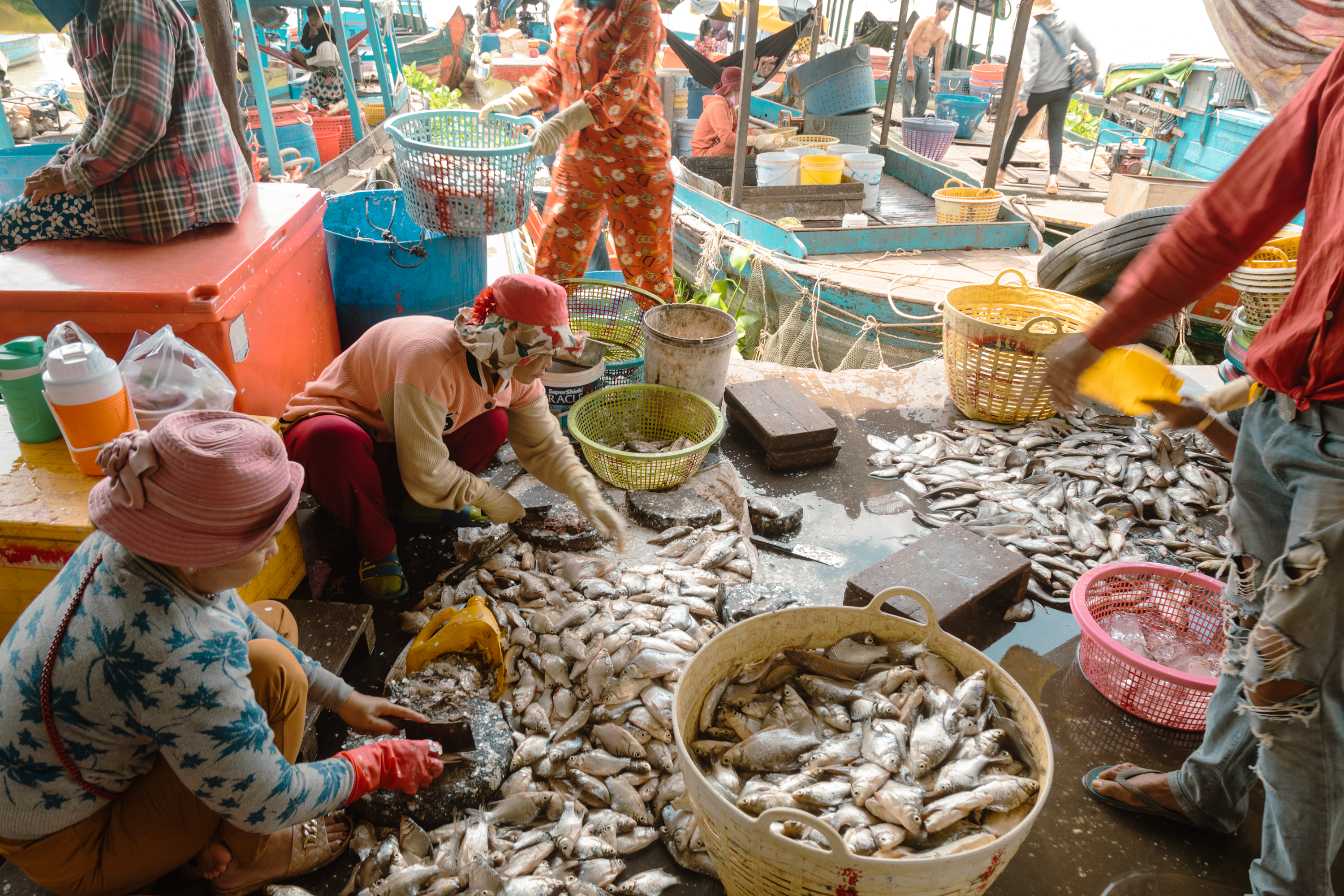
A Vietnamese fishing community sorts their daily catch on the Tonle Sap Lake, Cambodia. Photo by Nicholas Muller.
The effects have been felt widely among the most desperate. “The tragedy here is that people’s livelihoods depend on the fish caught in that lake, and they can’t fish at the level that they used to during this wet season. Once the wet season passes, the closed season will be lifted. There will be a lot of fish, but it will likely result in a reduced fish catch this year,” said Eyler.
To the relief of millions, the Mekong had a significantly stronger year compared to the previous three and the river is bouncing back. “The [Tonle Sap] expansion is happening in earnest, it is a little bit lower, but the data suggests it is happening. The fishers expect it to have a higher yield this year. Community fisheries are increasing,” said Eyler. Now that the wet season has drawn to an end, for the first time in four years, seasonal flood levels returned to a more normal state in line with historical averages. Eyler tweeted in mid-October: “Ladies and Gentlemen, for the first time in four years, we’re happy to present to you, the Mighty Mekong!” This year, the late flood pulse peak will likely offer much-needed relief to the Tonle Sap and its fisheries.
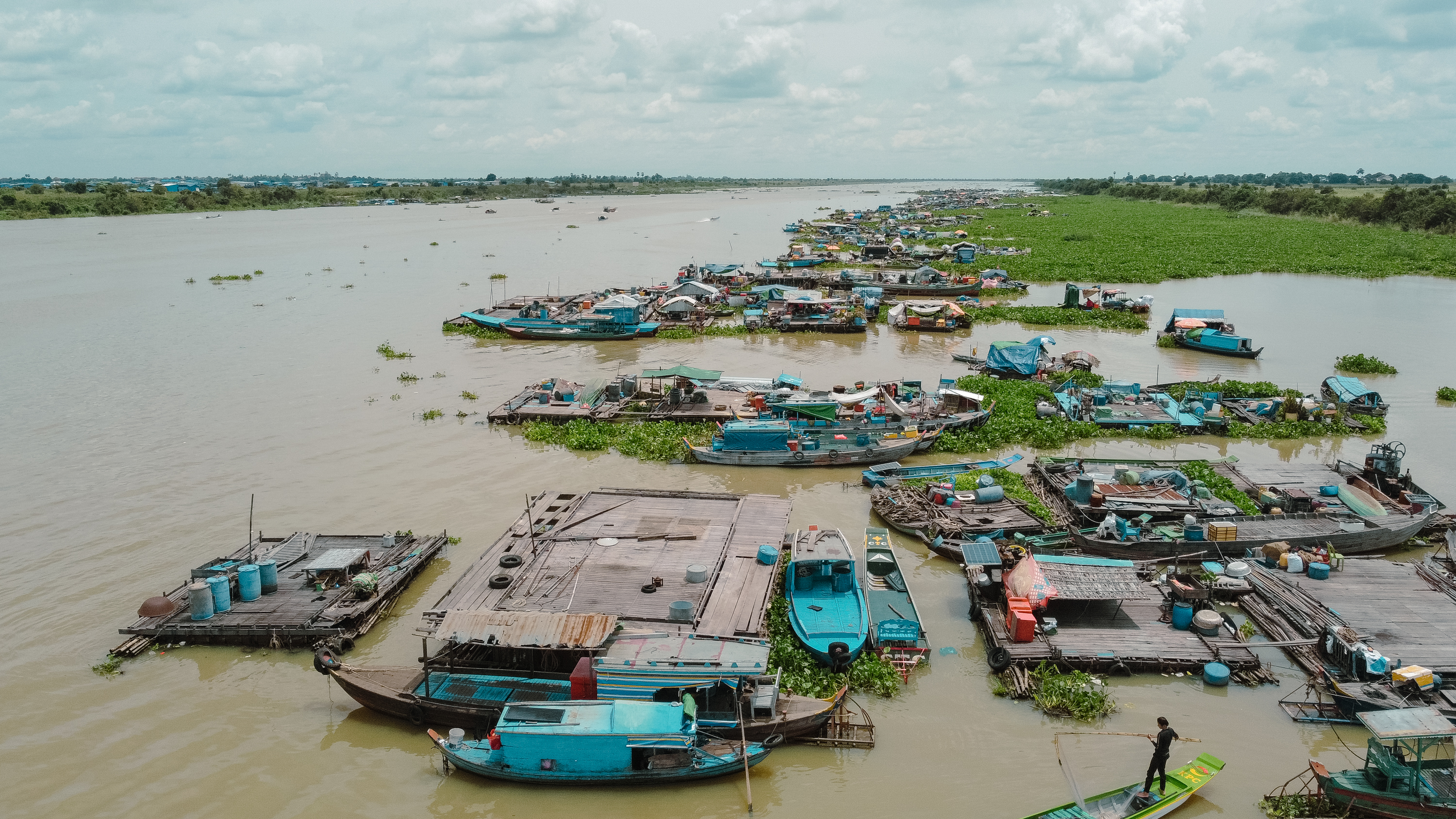
One of the several floating fishing villages on the Tonle Sap Lake, Cambodia. Photo by Nicholas Muller.
Increased Hope for Regional Cooperation
From a governmental perspective, Eyler sees a reflection of urgency at the national level among Mekong countries. “I think that Thailand, Cambodia, and Vietnam are equally alarmed about what is happening along the river’s course and its tributaries and the communities, but in different ways,” Eyler says.
Eyler hopes new tools to monitor the river will be more widely adopted across the region and by ASEAN and there is a lot of focus on supporting the MRC and turning it into a more effective institution. “ASEAN shies away from the geopolitical issues related to the Mekong and likes to avoid controversy, but [can] only avoid them for so long before they become very apparent as something that needs to be addressed,” he says.
There is also an understanding that officials are actually using the Mekong Dam Monitor to keep up with how dams and other things are impacting the river. “The MDM has proven to be a catalyst for positive change in the region, officially endorsed in Thailand and Vietnam’s national Mekong committees. Laos and Cambodia have yet to do so.”
So is the MRC, which has begun to use MDM data for public research publications and their own planning purposes. “They’re taking the data with their joint study with China and therefore have a lot of leverage over the data that China presents to them and a more level playing field,” he says.
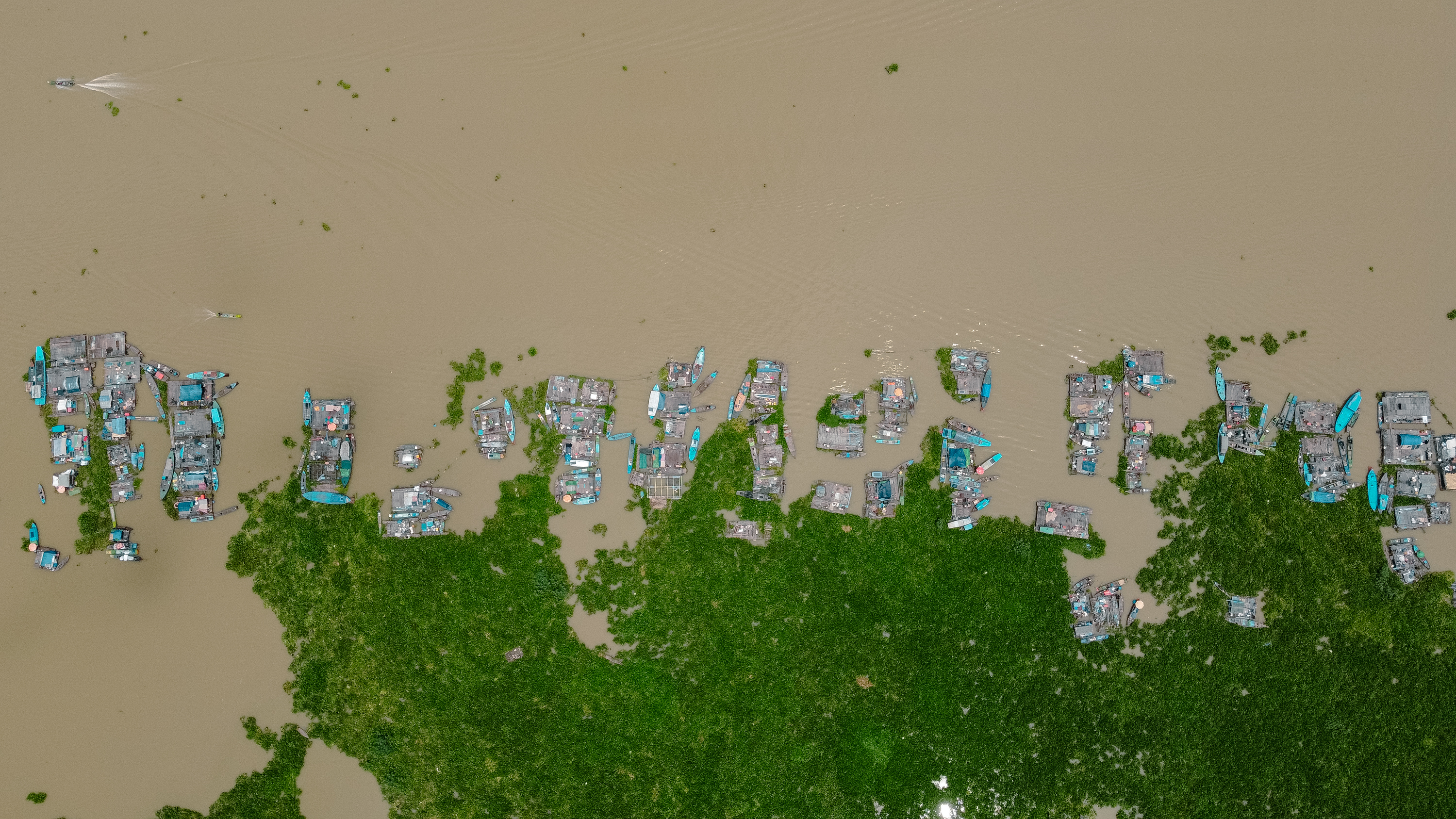
An aerial view of a Vietnamese floating village on the Tonle Sap, Cambodia. Photo by Nicholas Muller.
Baird of the University of Wisconsin-Madison says that state interests need to be put aside for the sake of the Mekong. “Unfortunately, there’s been too much focus on national interests and not enough on the basin as a whole,” he says. “There needs to be less of a national focus and a bigger focus on shared issues. Those governments don’t seem to recognize them, or those groups don’t have enough leverage.”
Eyler sees the only viable pathway that produces a healthier river system as one of regional cooperation. This means scaled-up cooperation among all parties along the Mekong and sees Thailand, Cambodia, and Vietnam each having somewhat national-level interventions, even aligning to a degree, but those interventions don’t speak to each other and don’t coordinate.
He, along with other Mekong experts, sees Laos as a major problem for the future of the river system. “Many more dams could be built and none of the dams built on the tributaries have environmental mitigation built into them like fish passages or sediment flushing gates, and China’s damage is done,” says Eyler.
“You really can’t preserve the health of the river system without smart regional cooperation,” Eyler says. “I just don’t see it among the downstream countries and there’s cooperation happening between the downstream and upstream with China that might produce a basin-wide operation approach, but again because of these diametrically opposing viewpoints, how that operations’ blueprint will be designed is unknown. All of this is happening amid the onslaught of climate change impacts, some of which are starting to hit, and yet to hit, and it’s just going to get worse.”
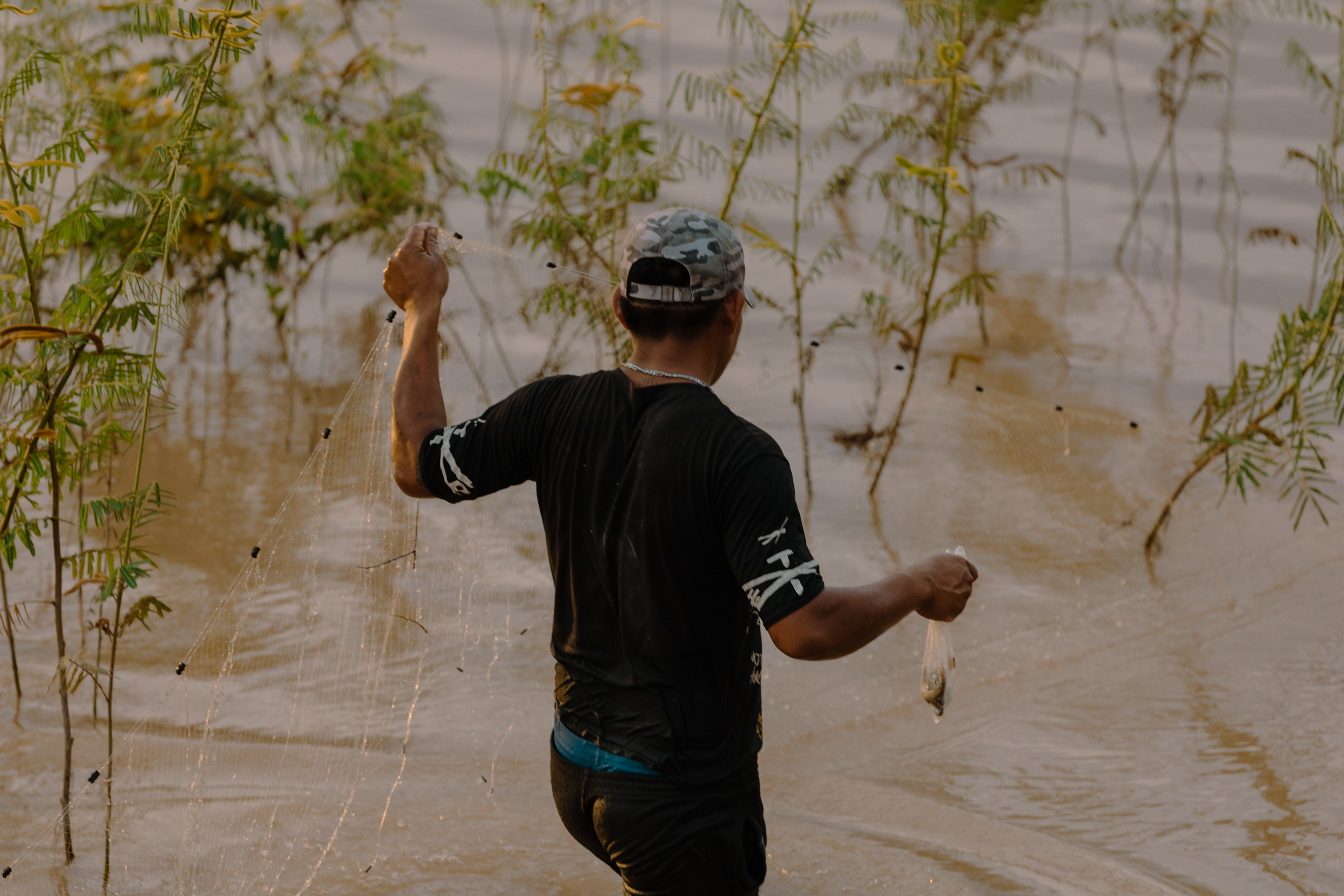
A fisherman examines his catch in Pakse, Laos at the end of the day. Photo by Nicholas Muller.
The Clock is Ticking
Zeb Hogan worries that the accelerating pace of upstream development and dam-building, coupled with cumulative impacts of transboundary stressors and the impending impacts of climate change, point to a common concern among those who work and live in the lower Mekong River Basin: a fear that the river, which is the lifeblood of most of Southeast Asia, will gradually become so fragmented that it will lose its function, and thus no longer support the huge diversity of wildlife and the millions of people that depend on it.
“More conservation action is needed. Many of the Mekong’s most iconic species are at risk of extinction.” Hogan’s involvement in the discovery of a 661-pound stingray in June “highlights both what’s at risk and what we can do to help save the Mekong’s amazing creatures.”
“The Mekong isn’t what it used to be. It’s flawed, but it’s not a totally lost cause, left there to be turned into one big dam now,” says Baird. “But, there are still millions of people relying on it for food and there is still a huge amount of fish and aquatic biodiversity, there are still amazing processes like fish migrations occurring in this river despite all of these things that are all causing lots of problems.”

An aerial view of the Si Phan Don, or 4000 islands, a riverine archipelago in southern Laos. Photo by Nicholas Muller.
Eyler says, “[the] MRC needs to bone up in its ability to prepare for the future and not just mitigate, but also deal with ways to compensate and help countries adapt and build adaptive measures into a very difficult time to come as the resource base of the Mekong really begins to unravel.”
He also believes those who live along the river are very committed to preserving the Mekong’s future. “There’s a deep love for the river among these people. This love is inscribed into the cultural stories and folklore of the Mekong communities,” he told WWF.
The crucial question moving forward will be how to safeguard the Mekong’s splendor for the future 100 million people who will critically depend on it in Southeast Asia.
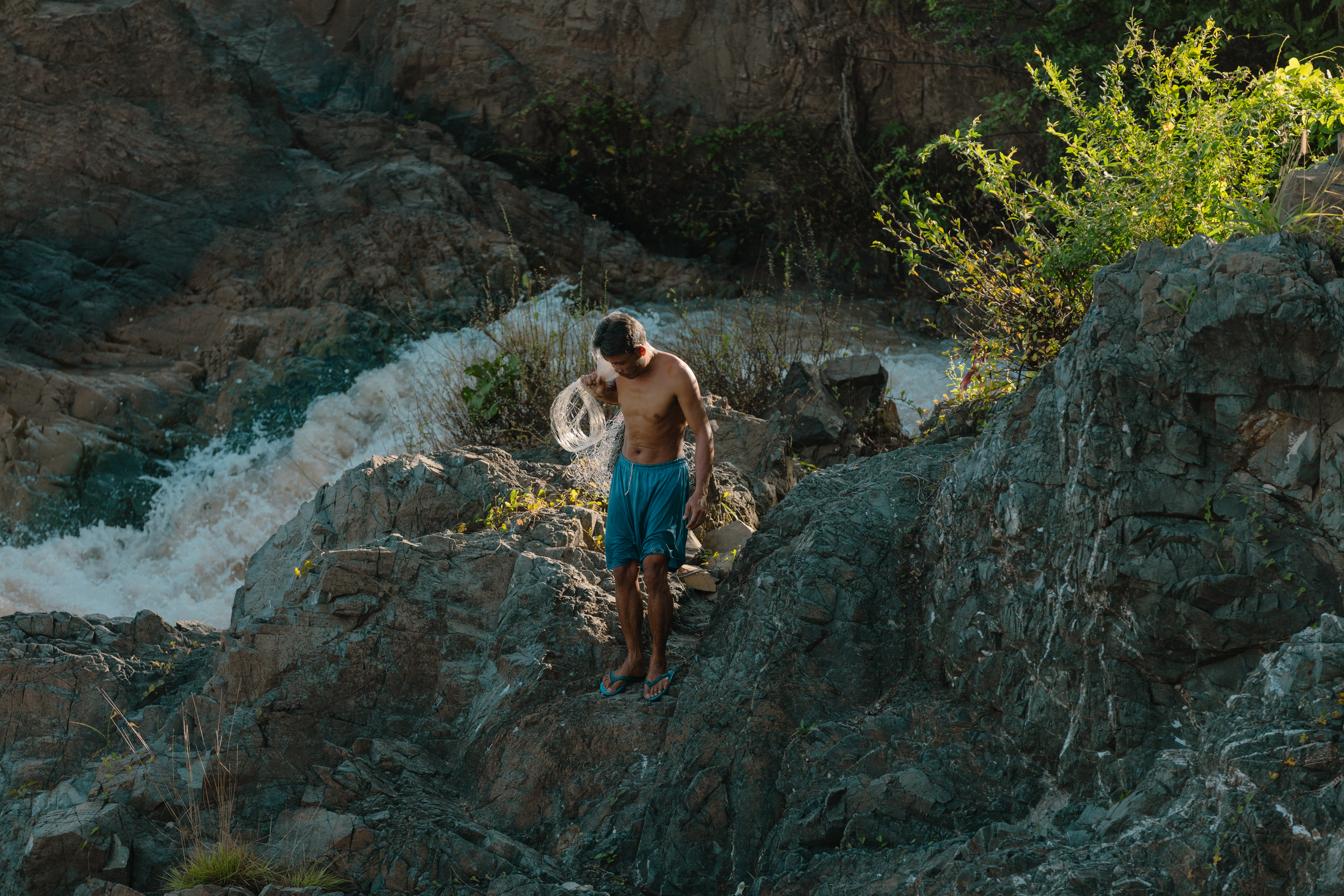
A fisherman takes his net down the rocks by the rapids to fish at Li Phi Falls on the border of Laos and Cambodia. The Mekong drops down here and is a breakoff point from its normal flow. Photo by Nicholas Muller.













